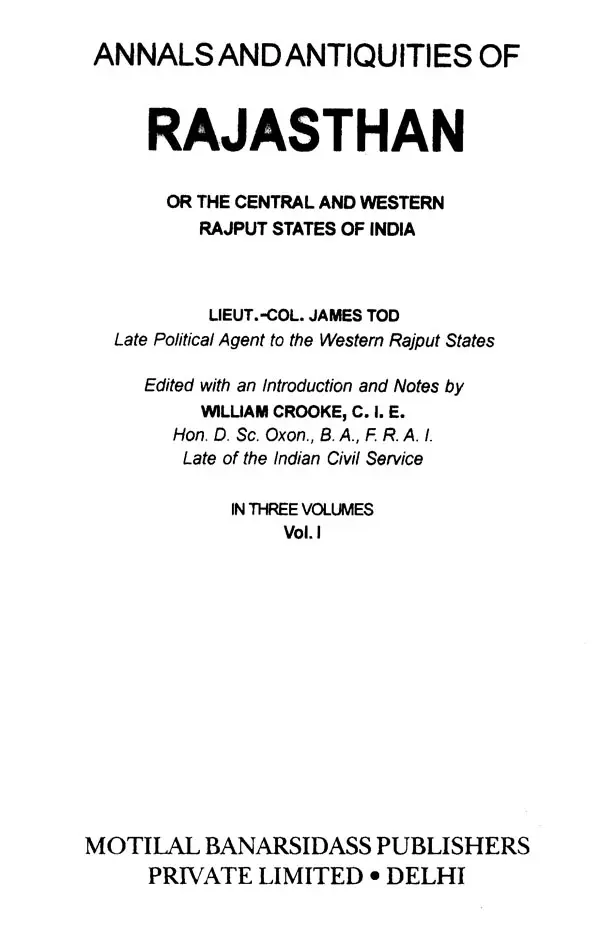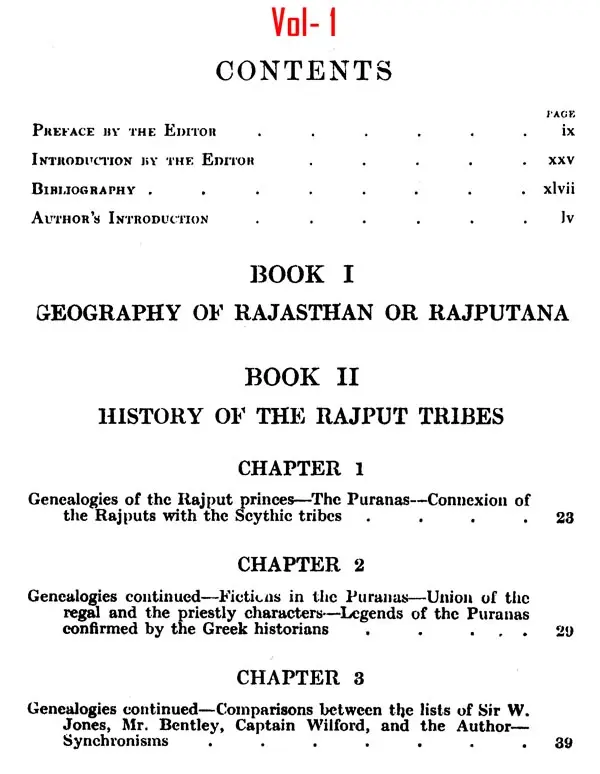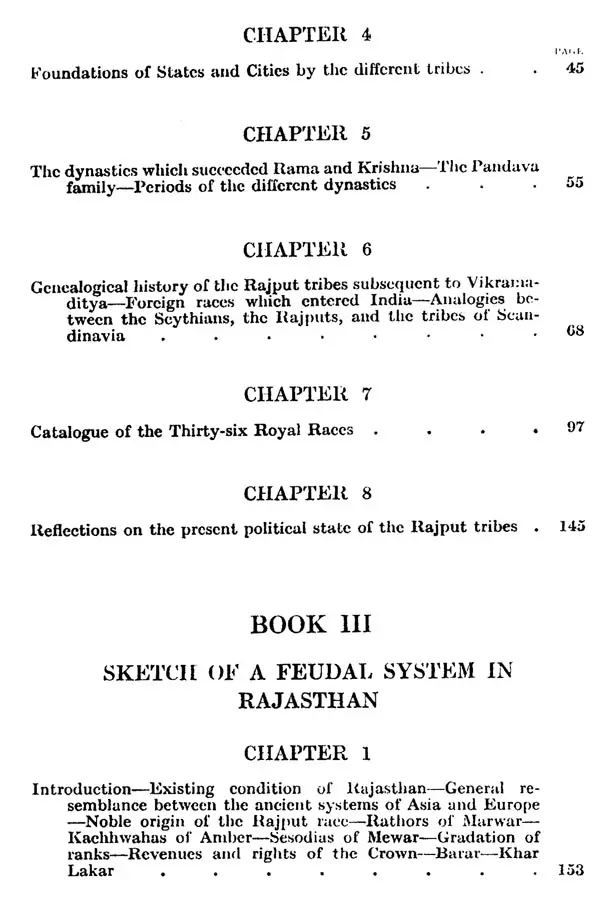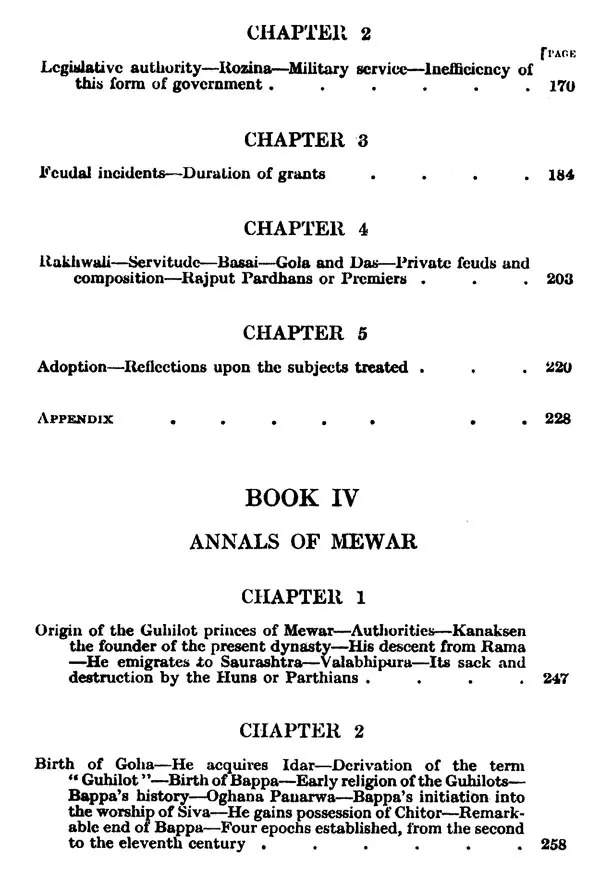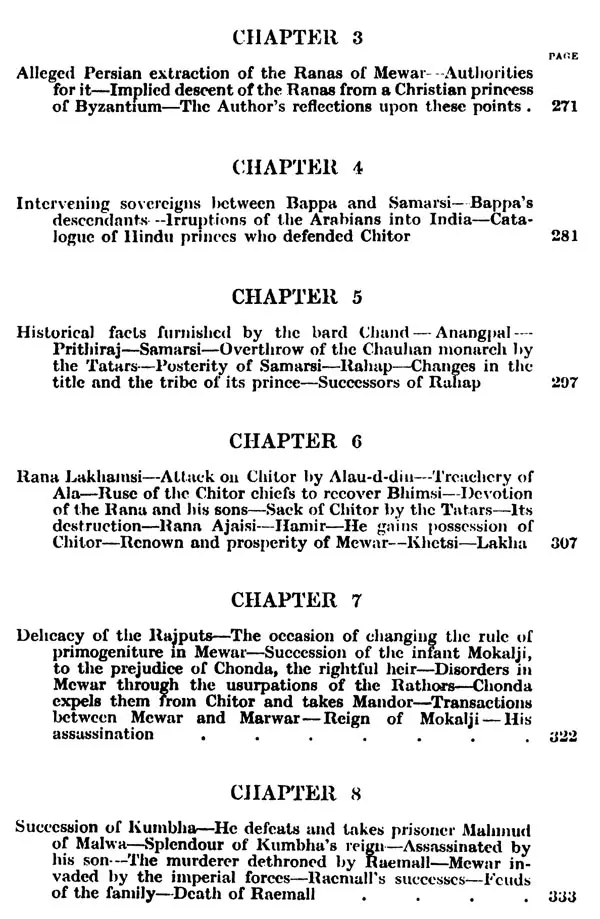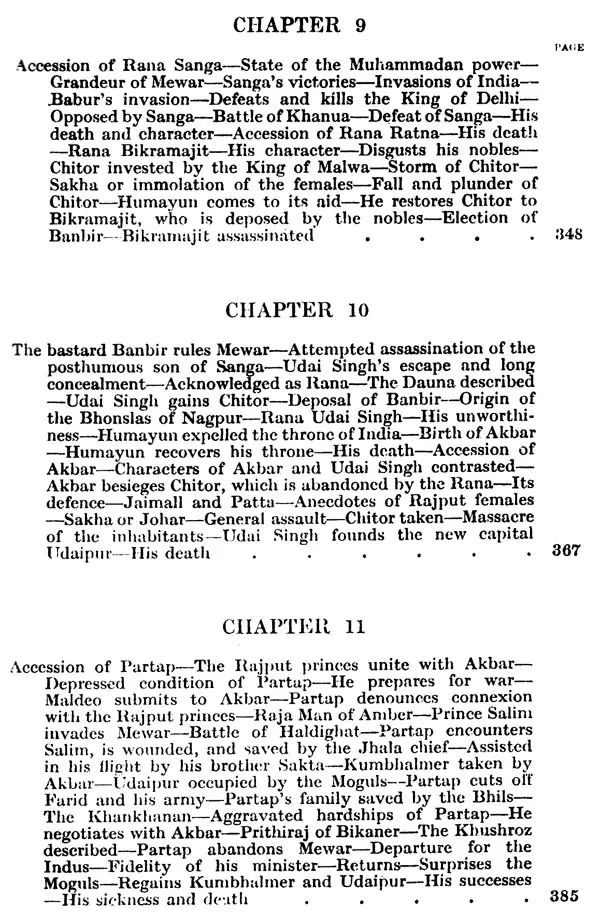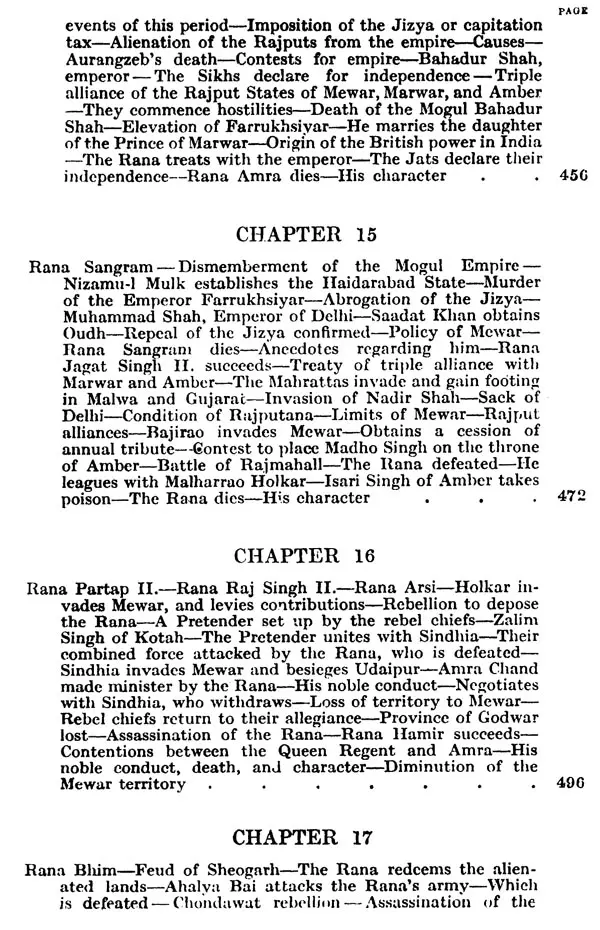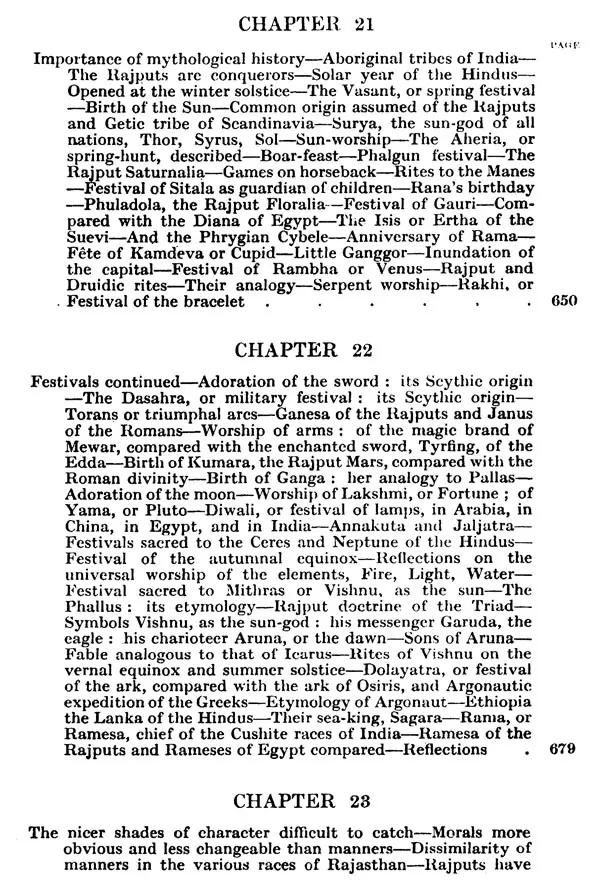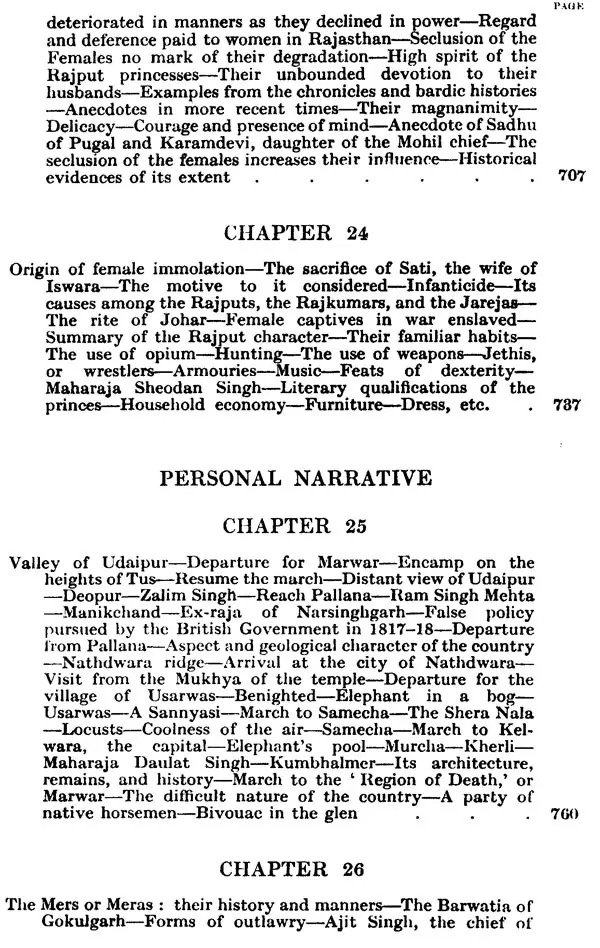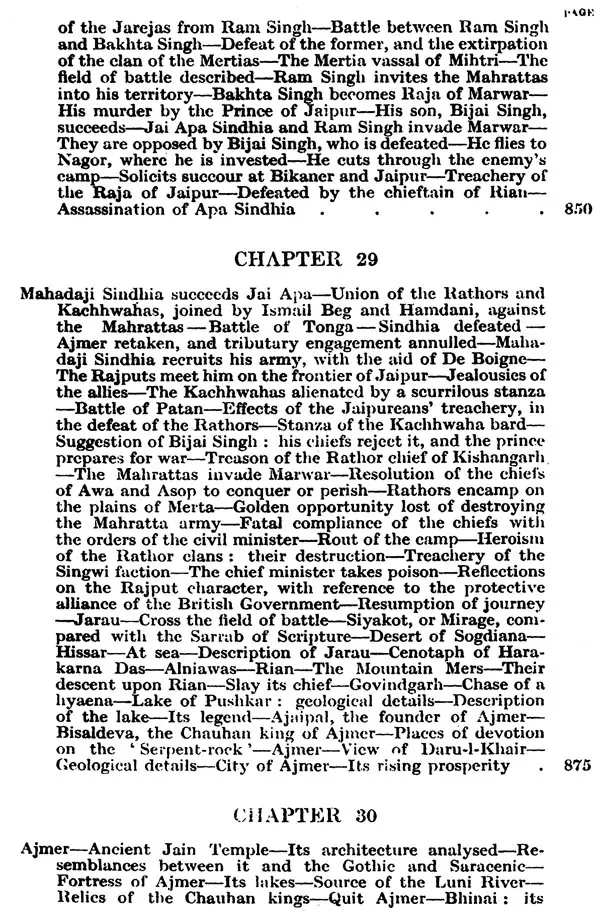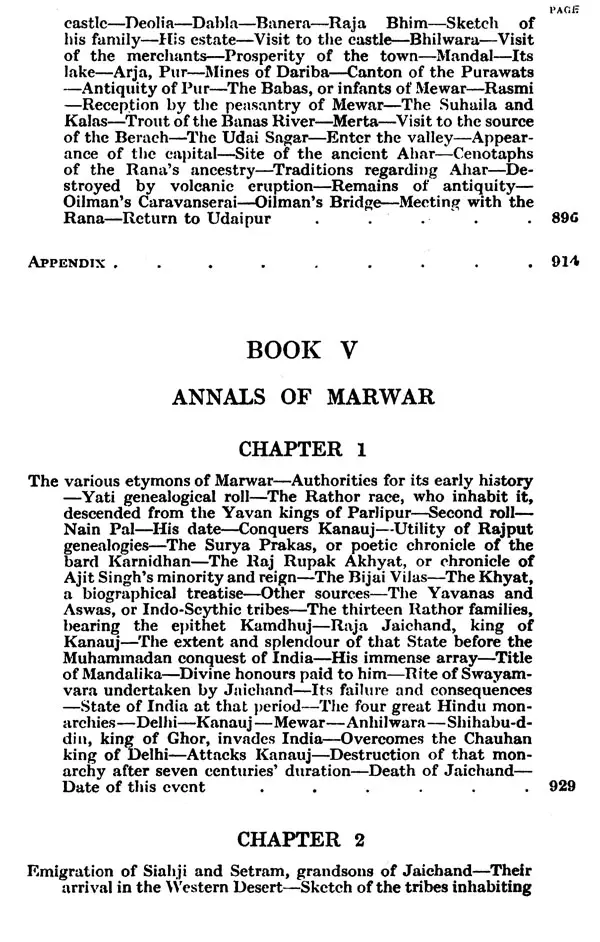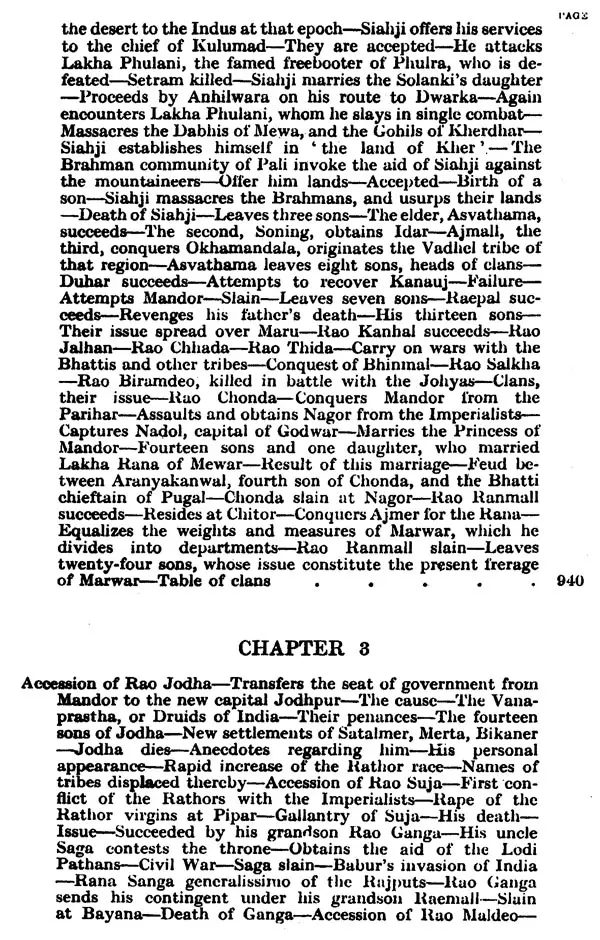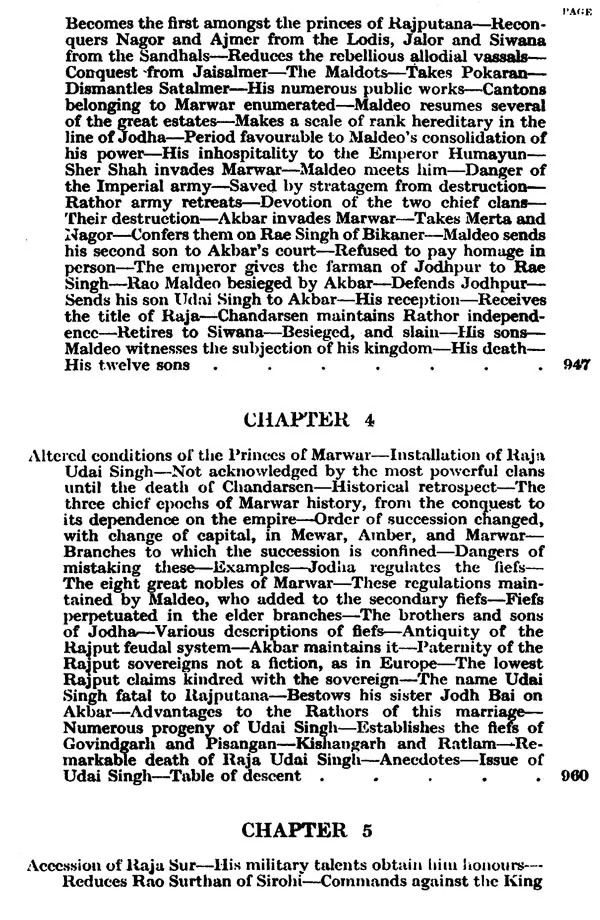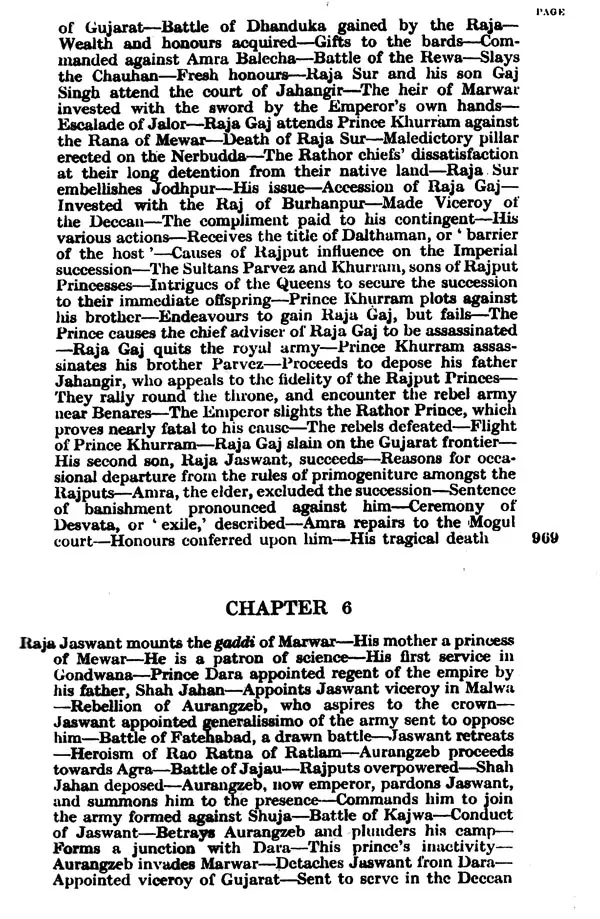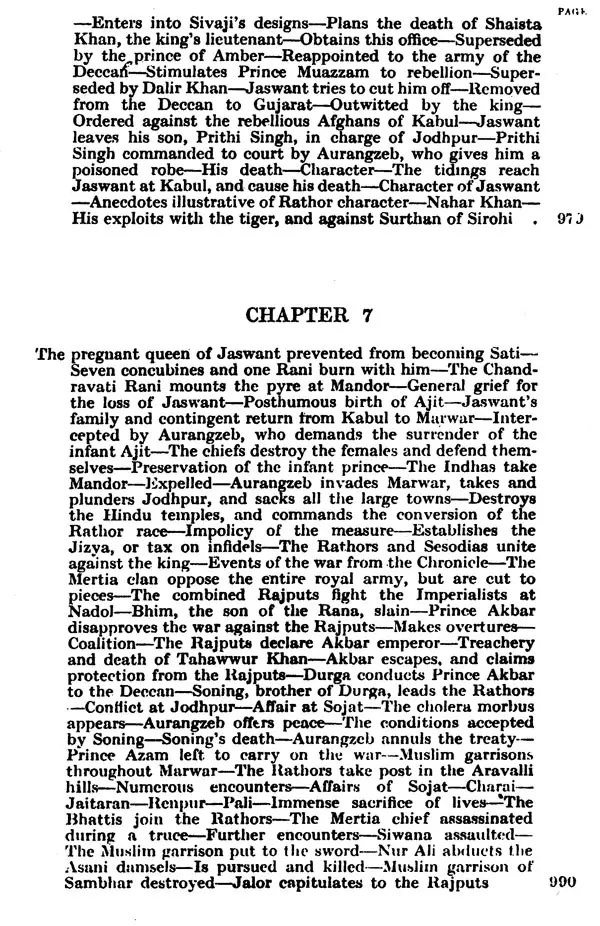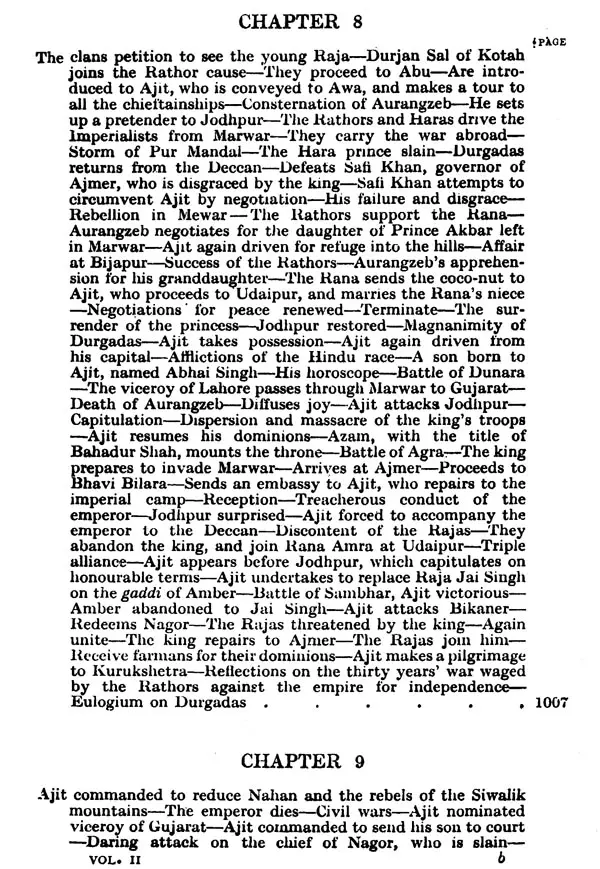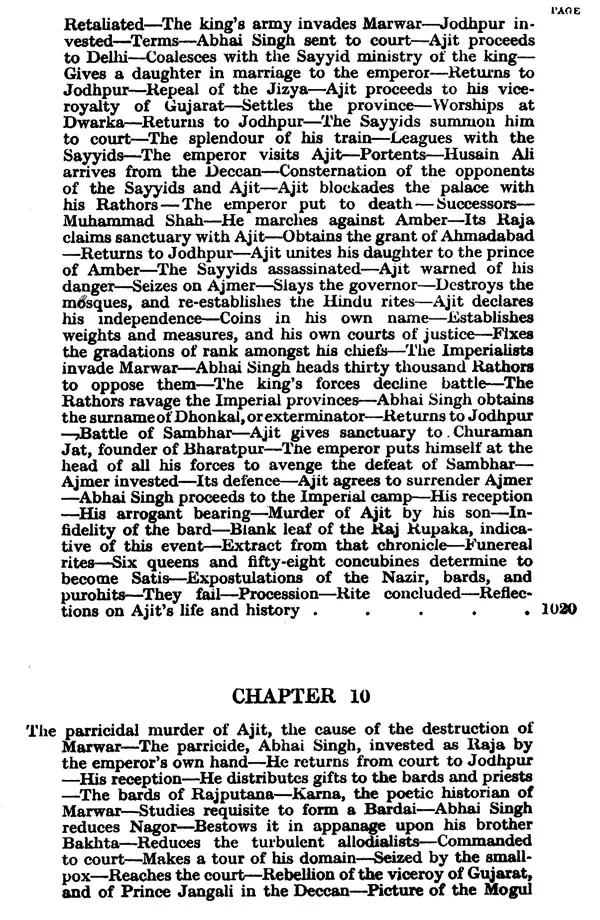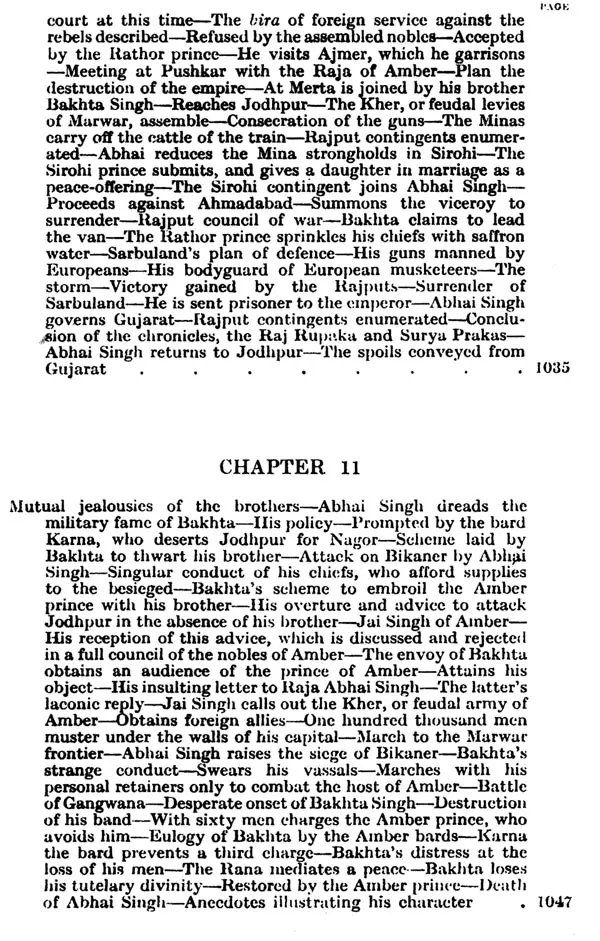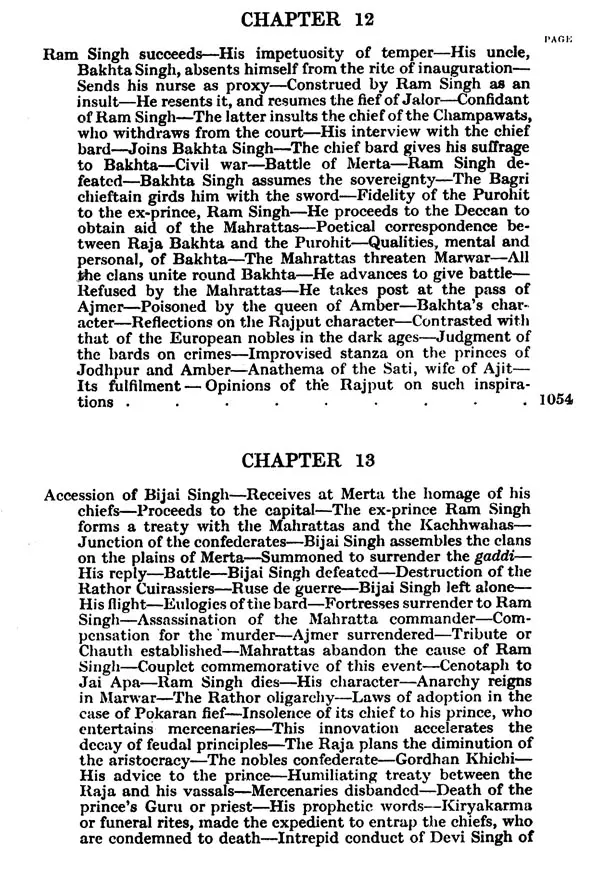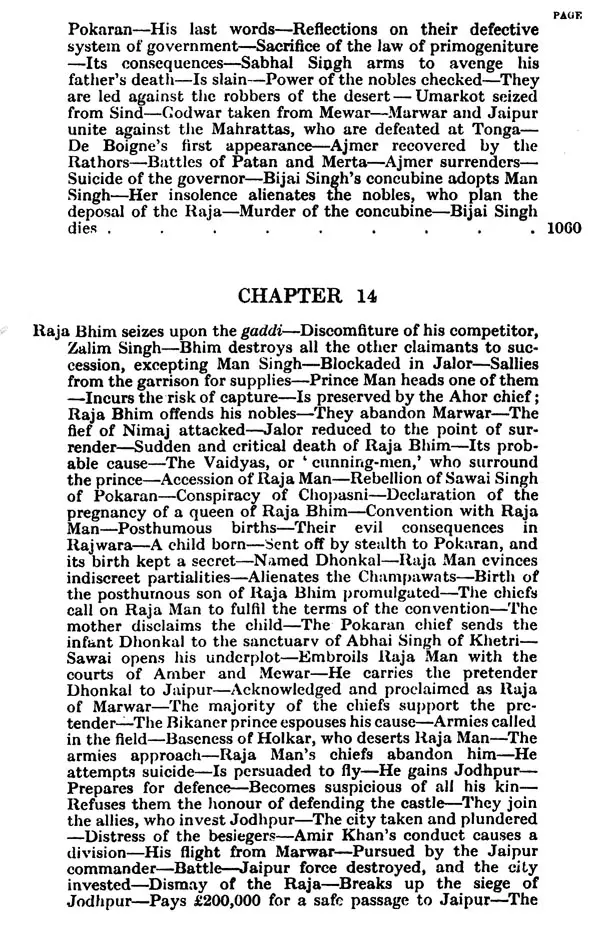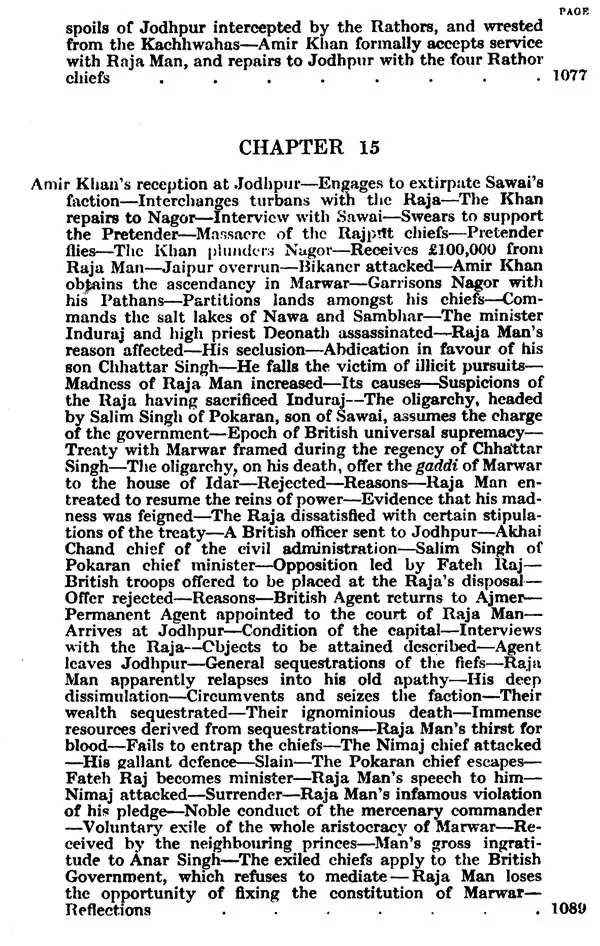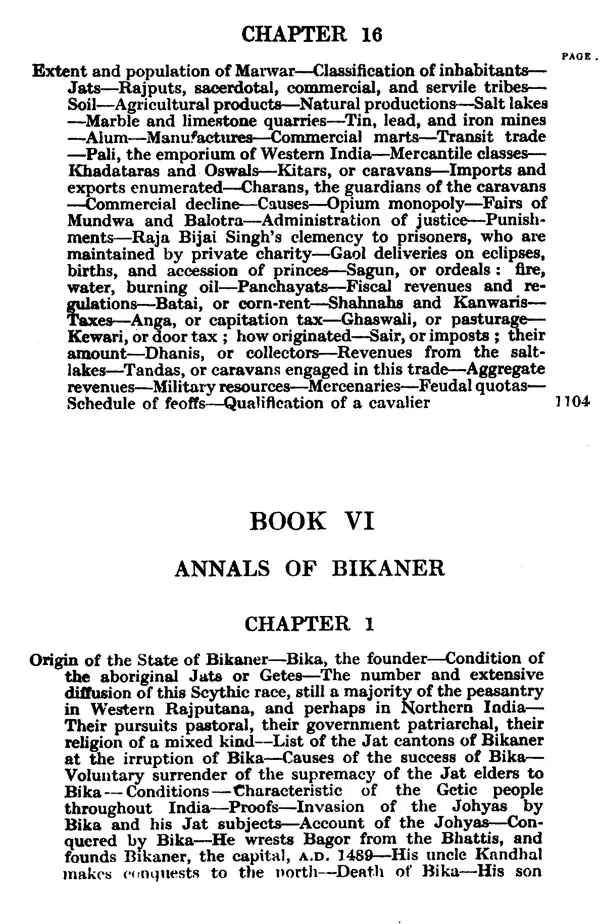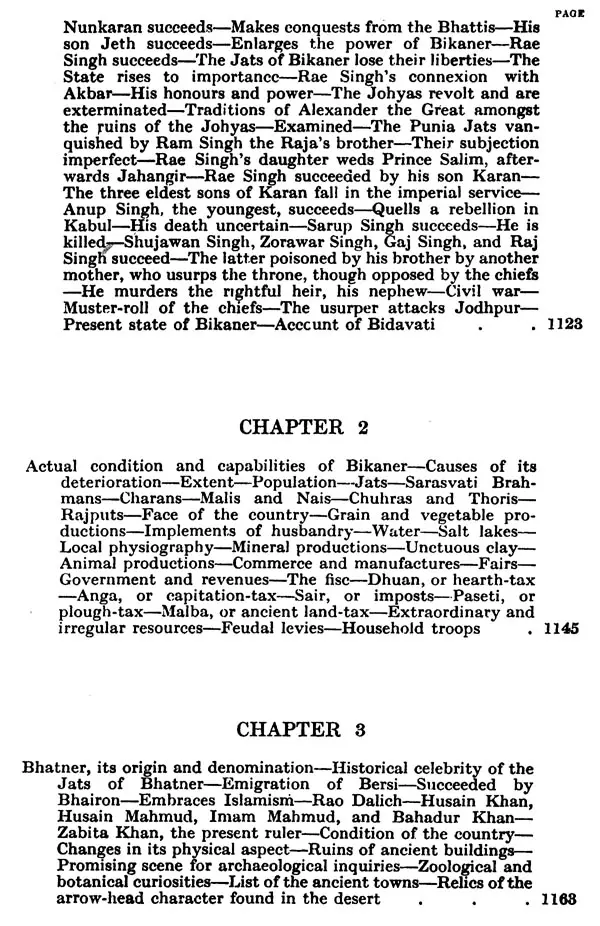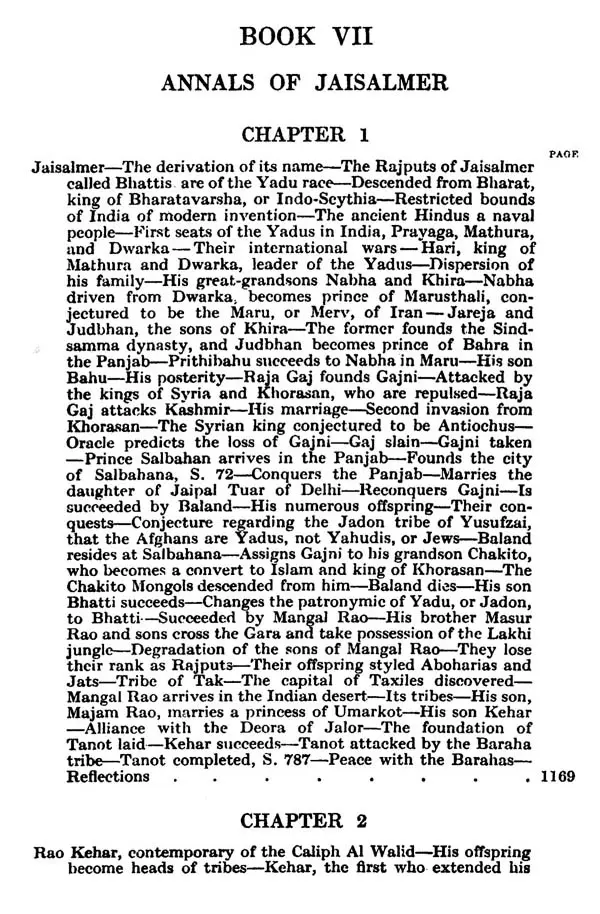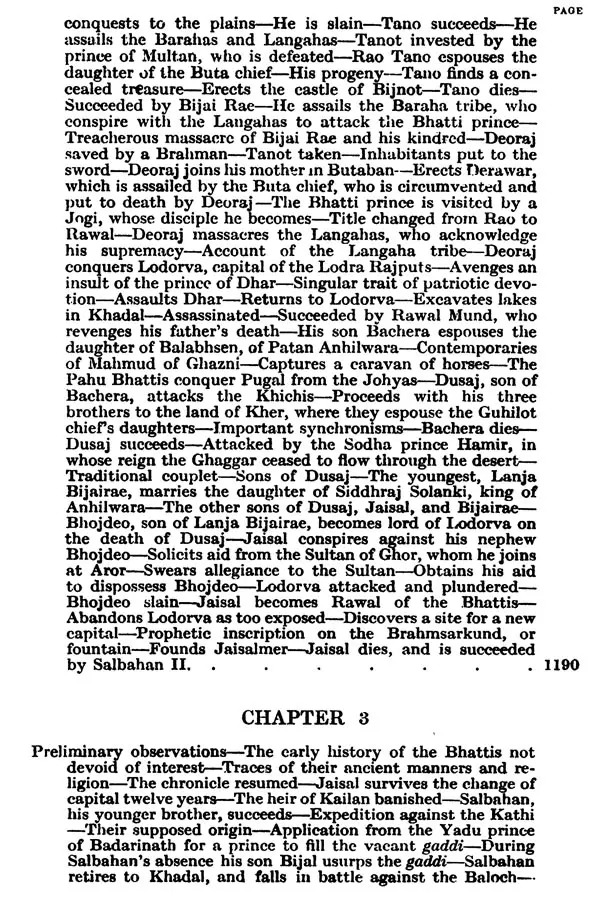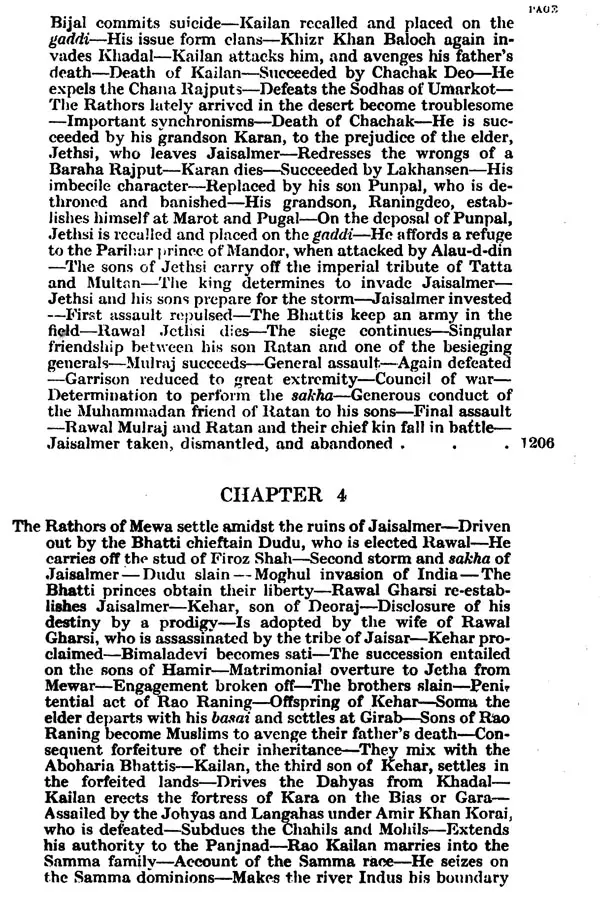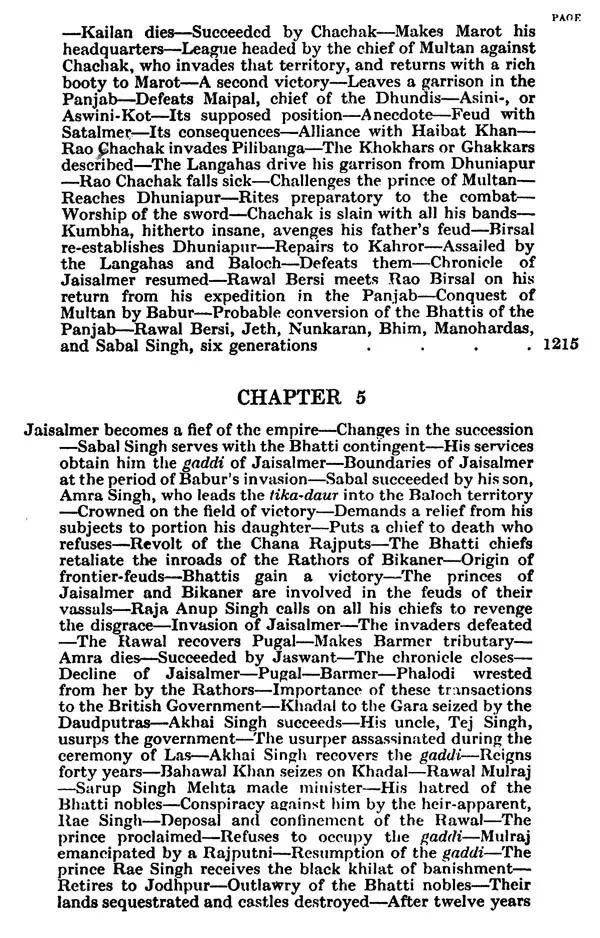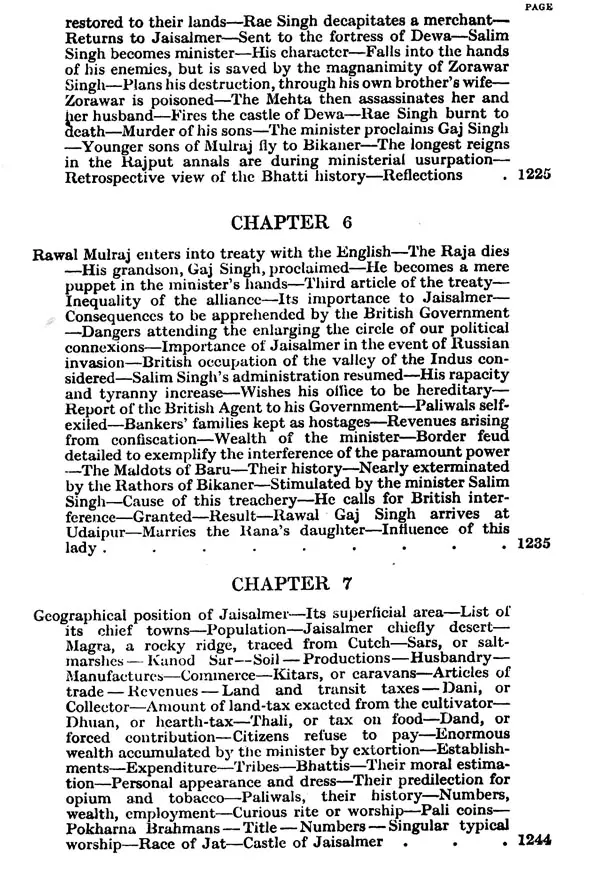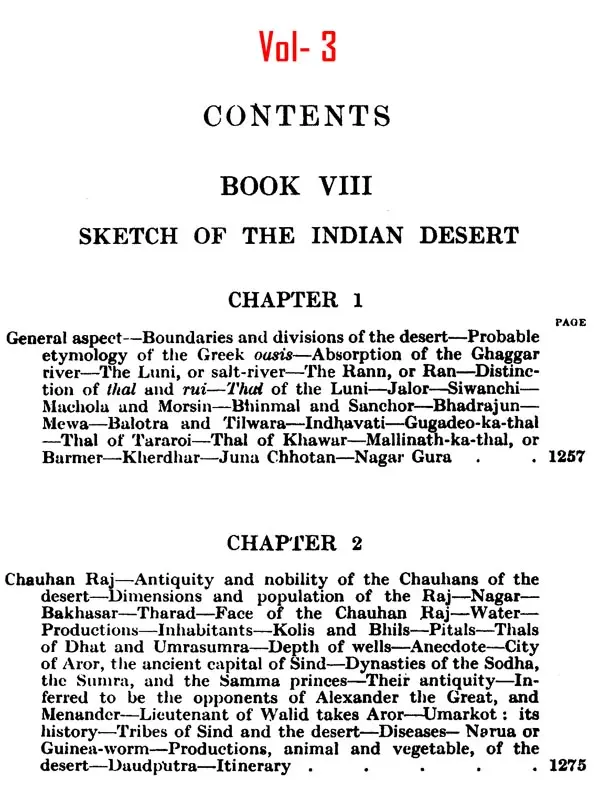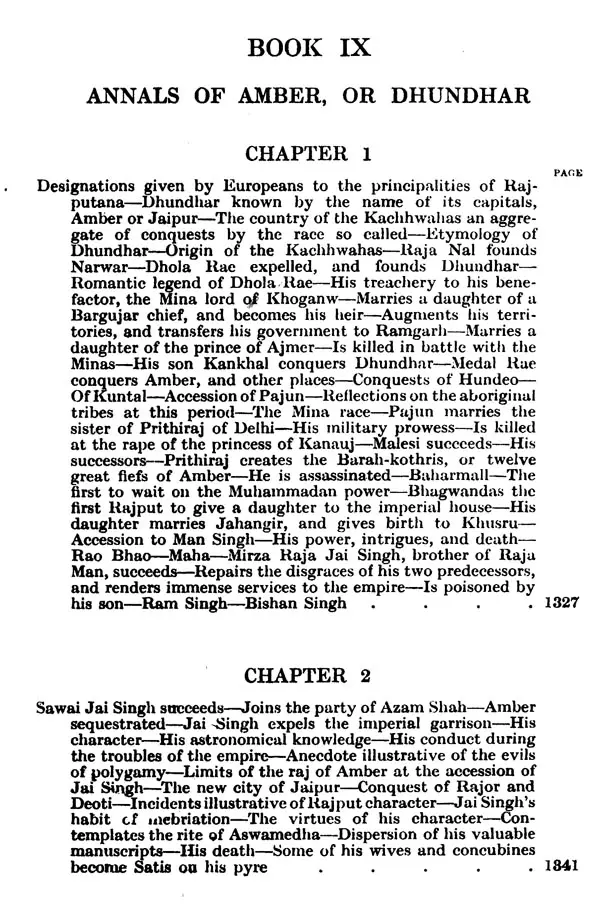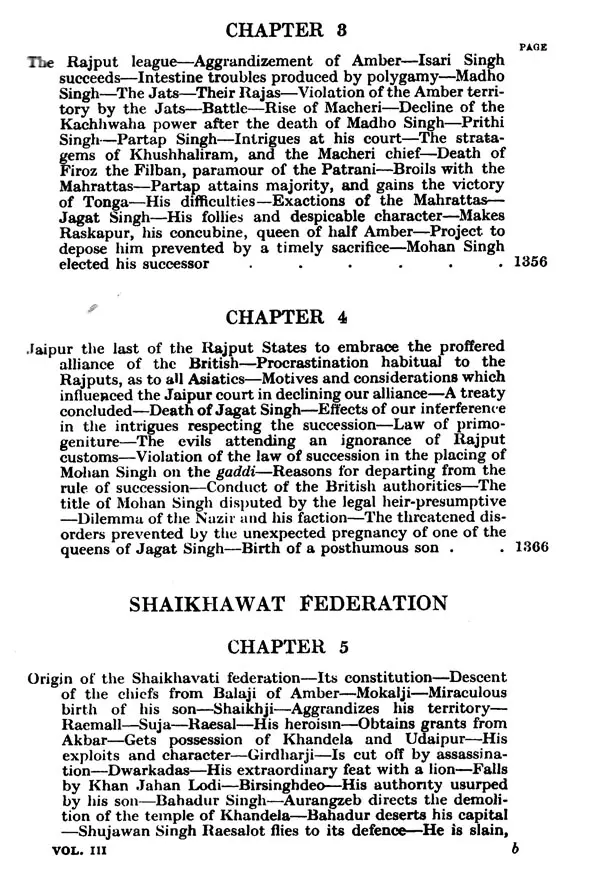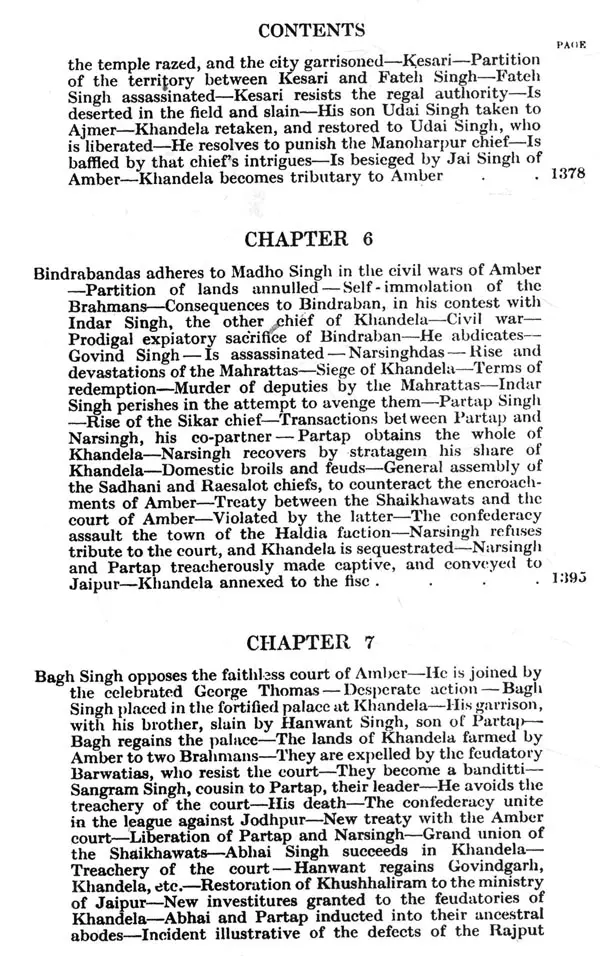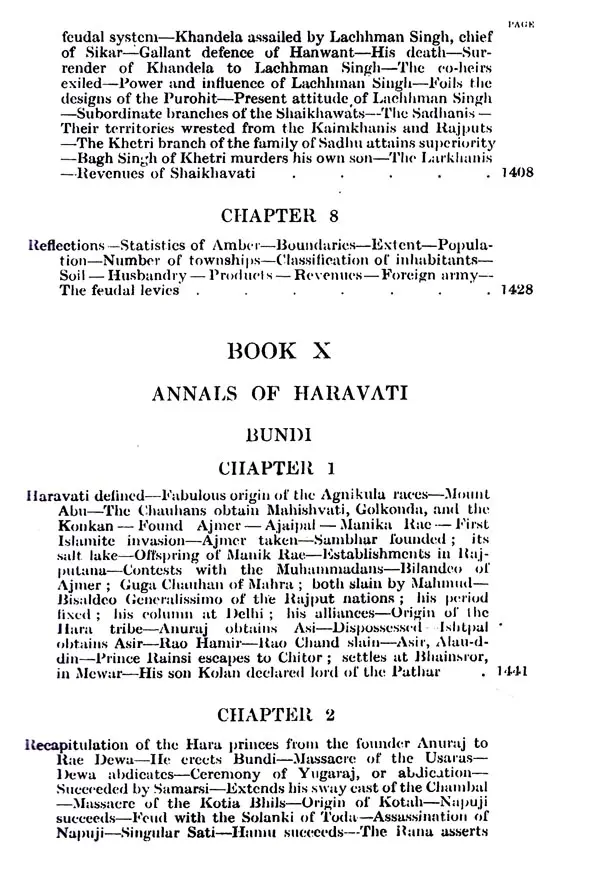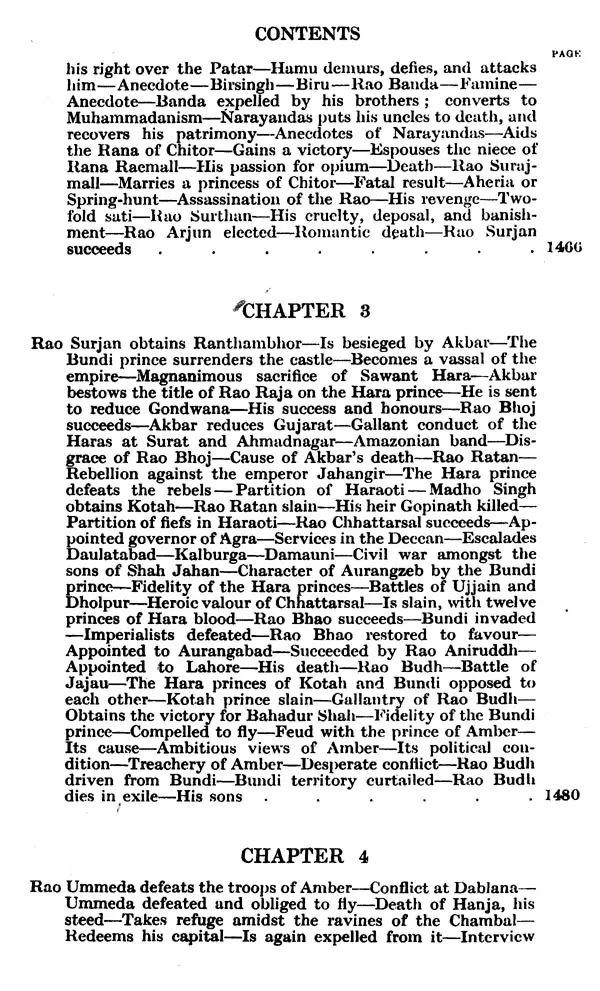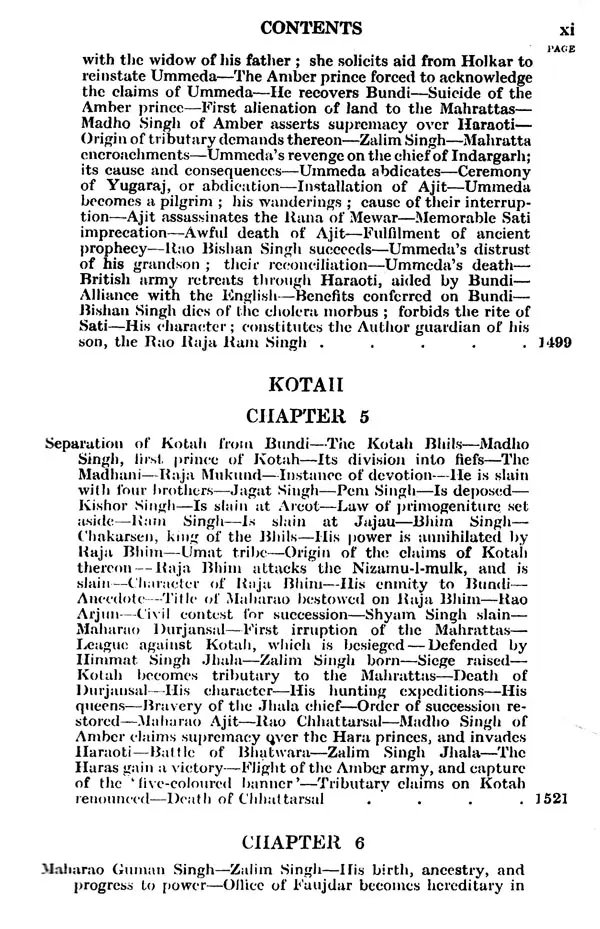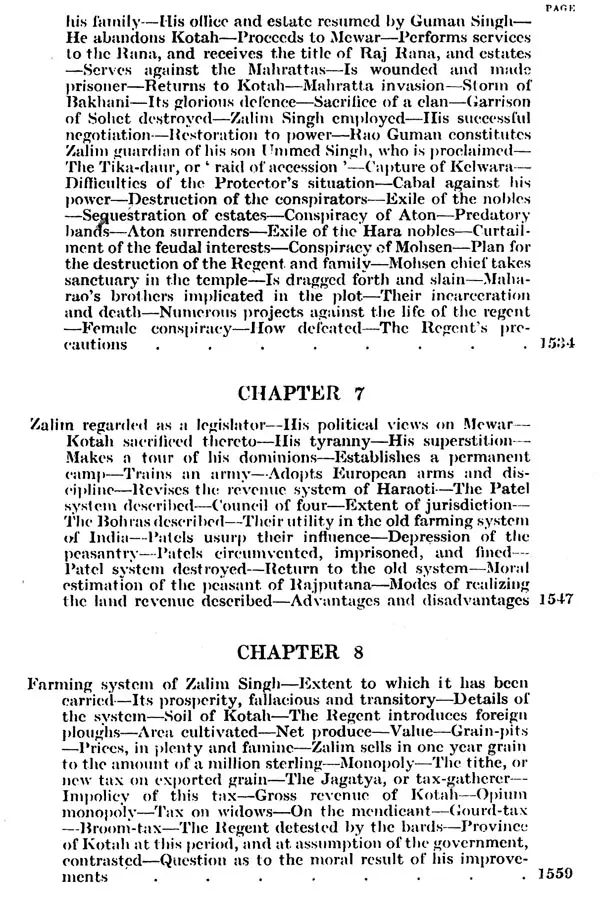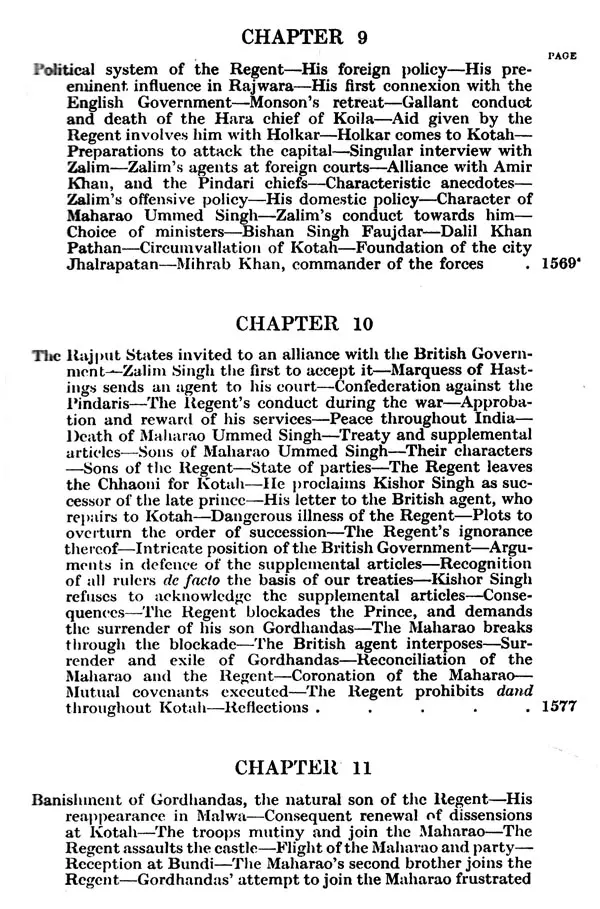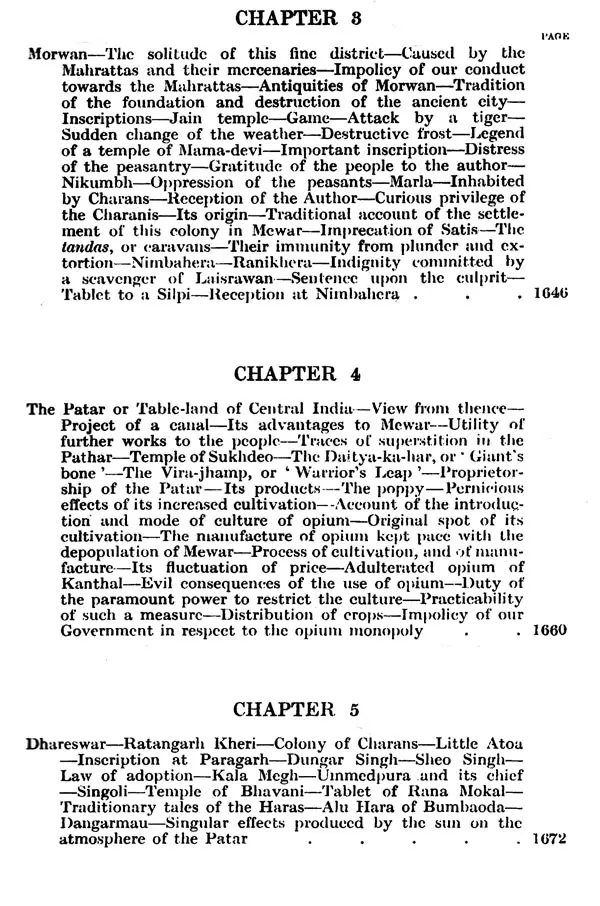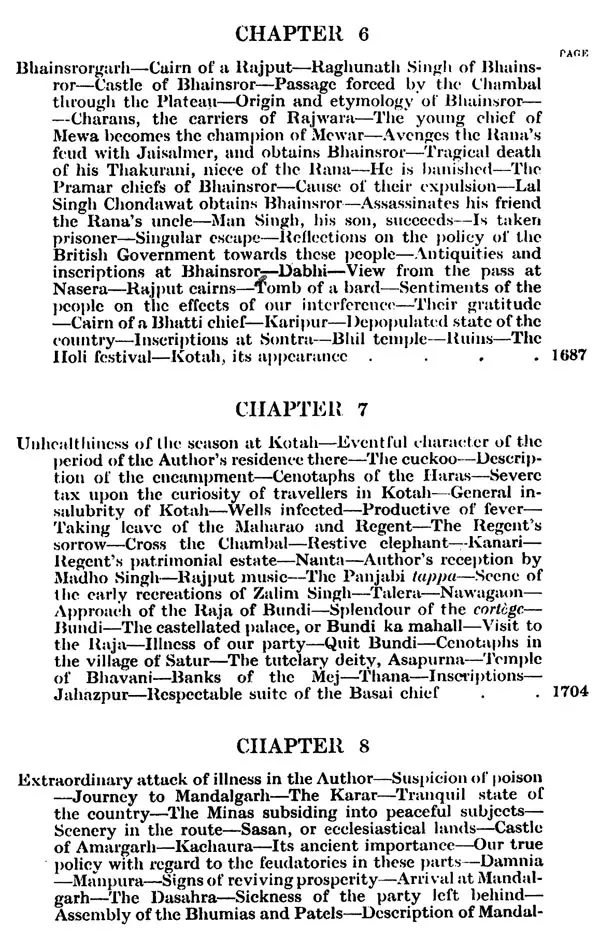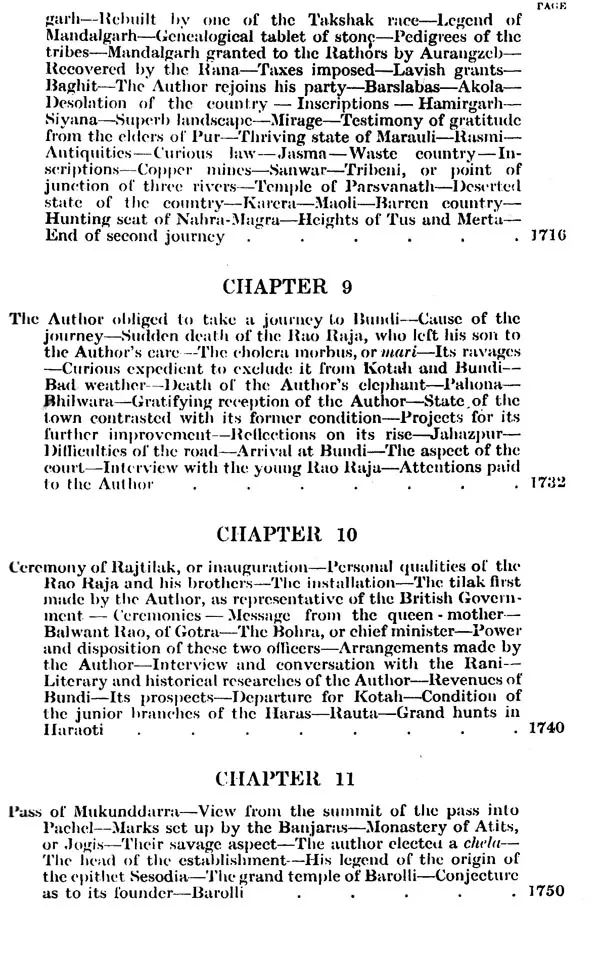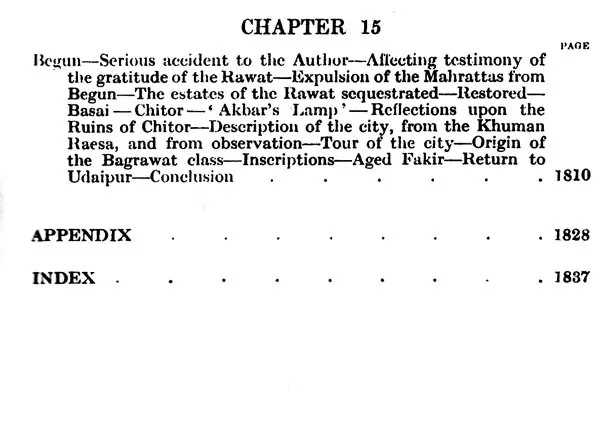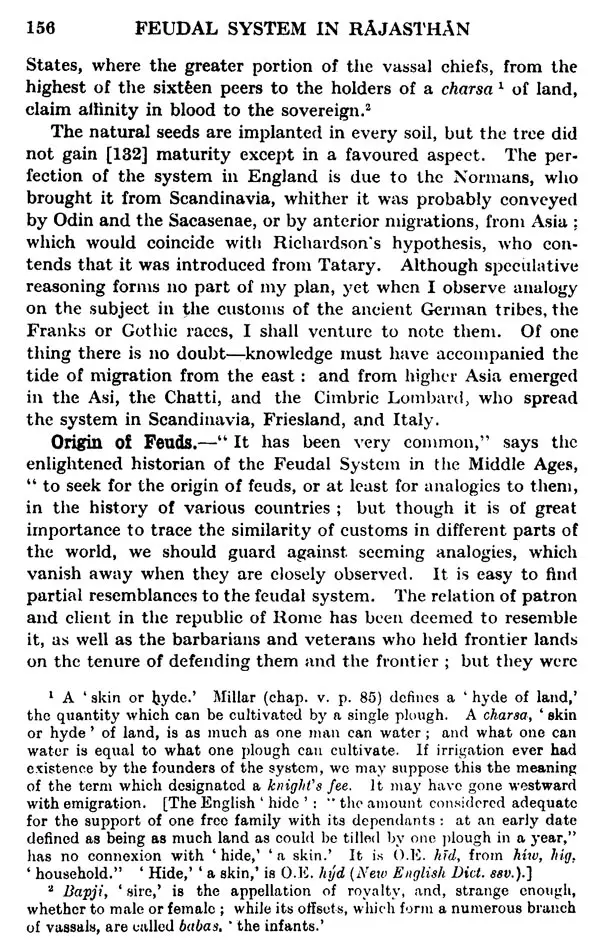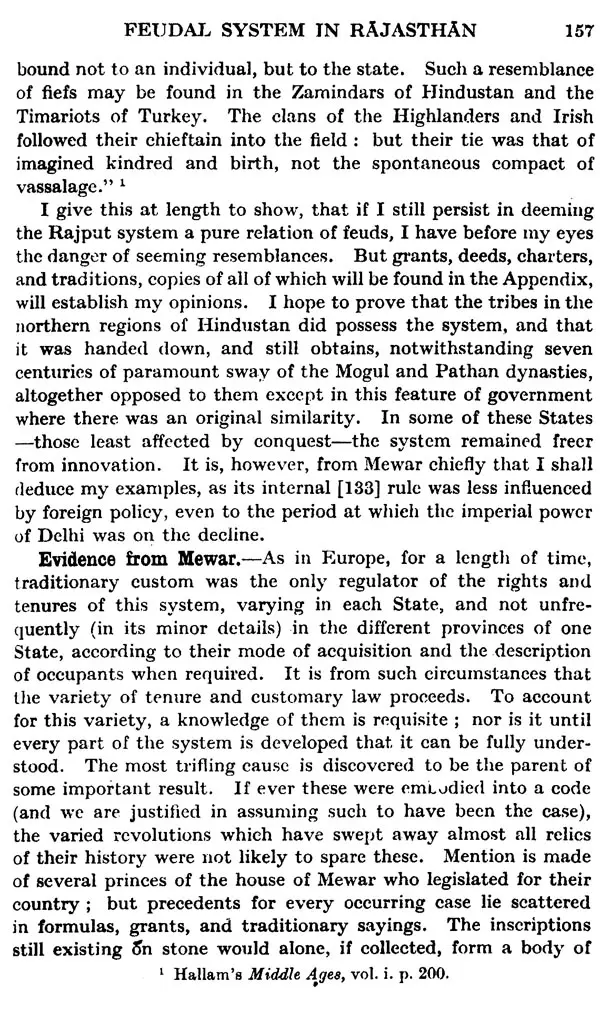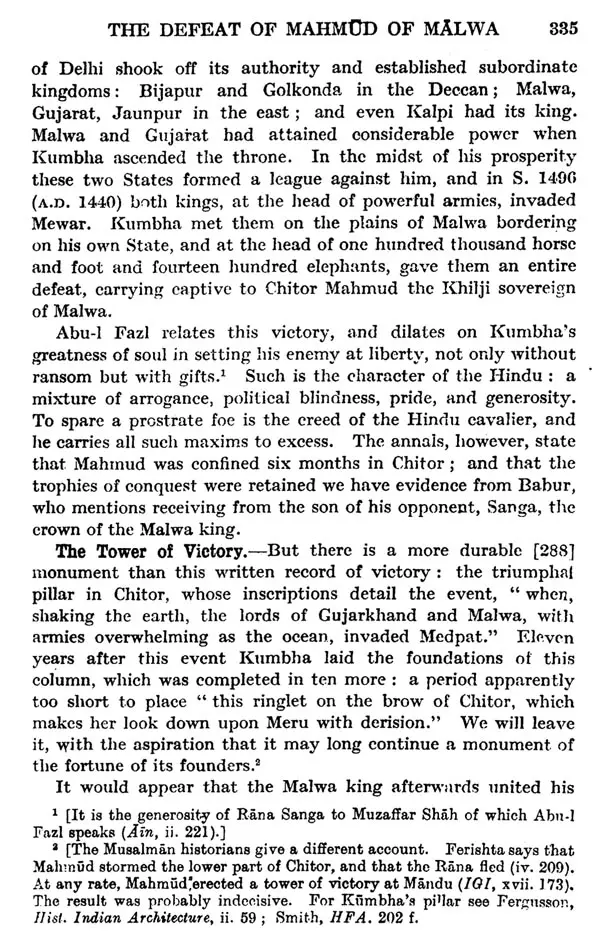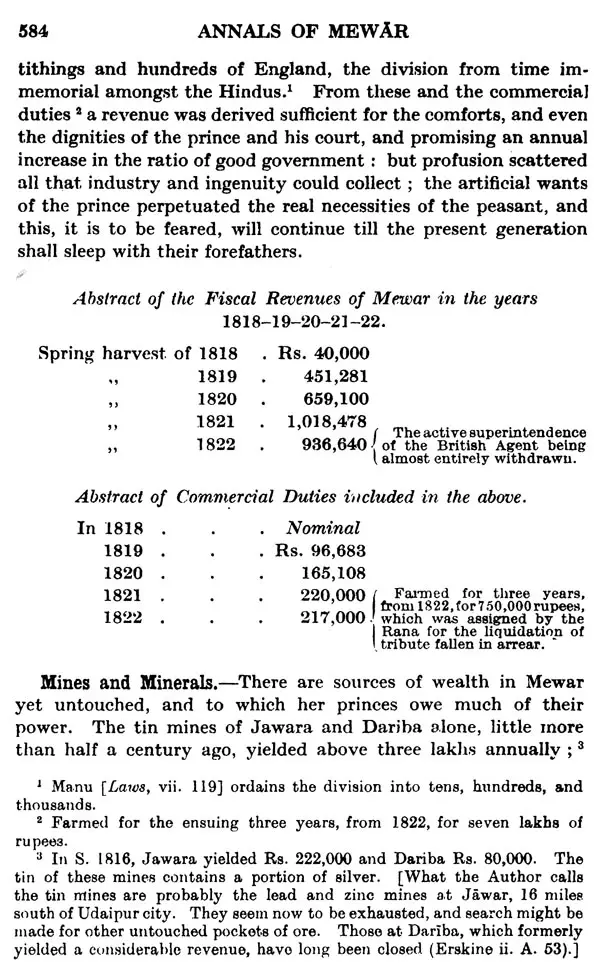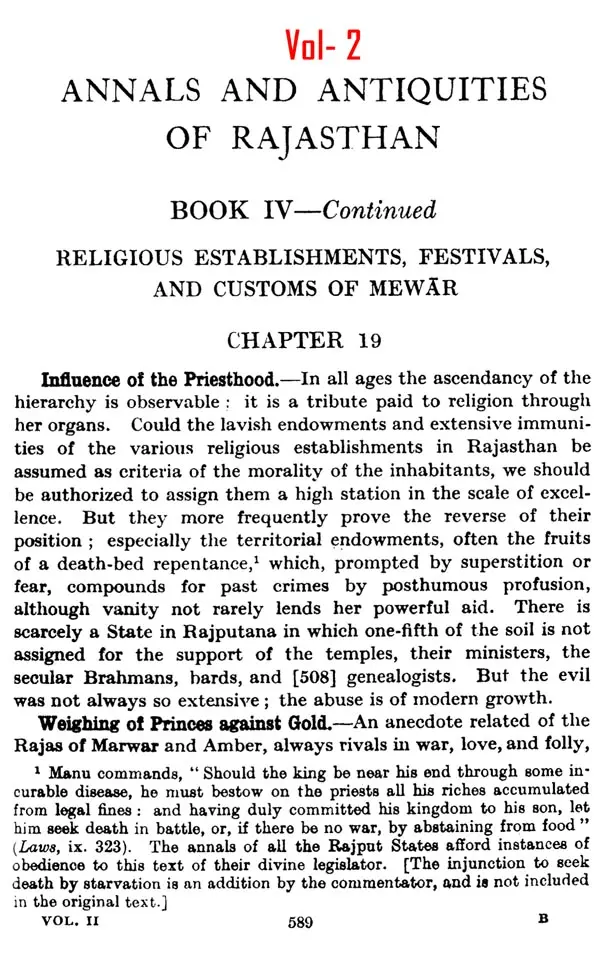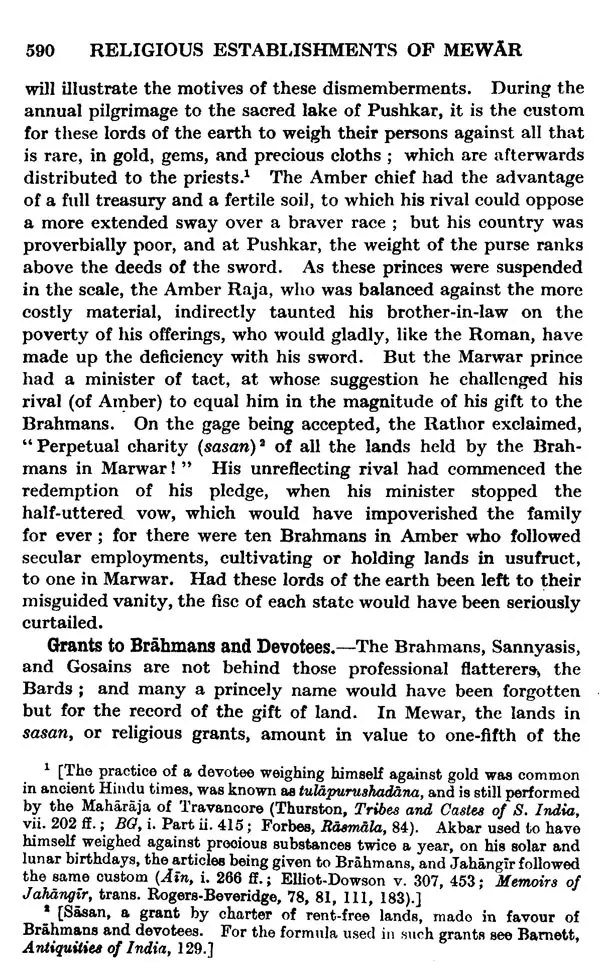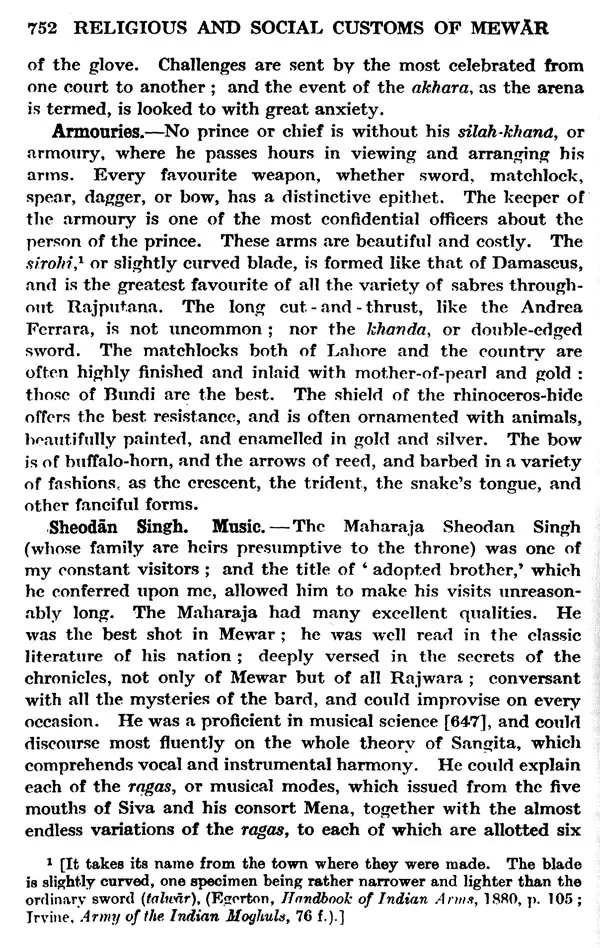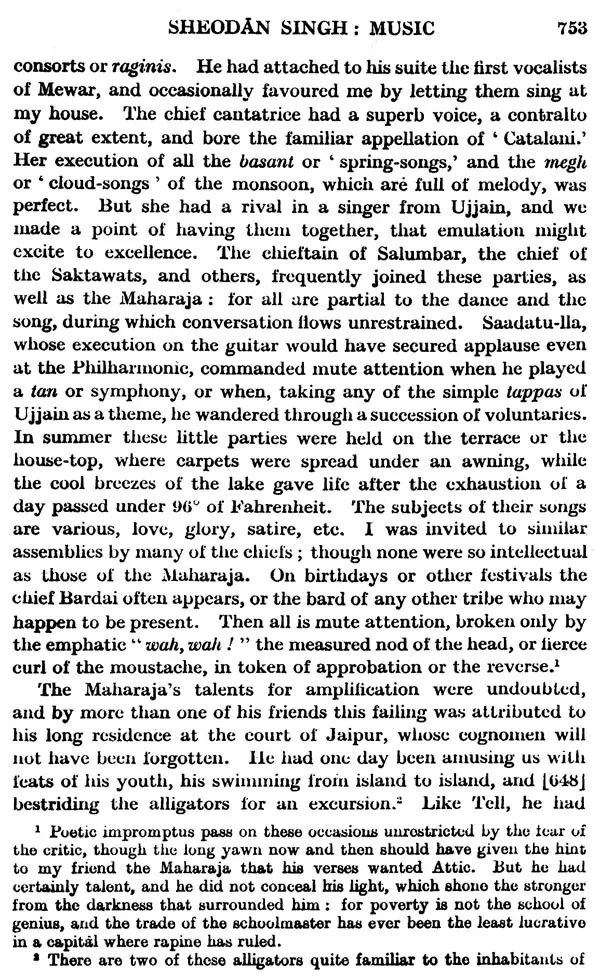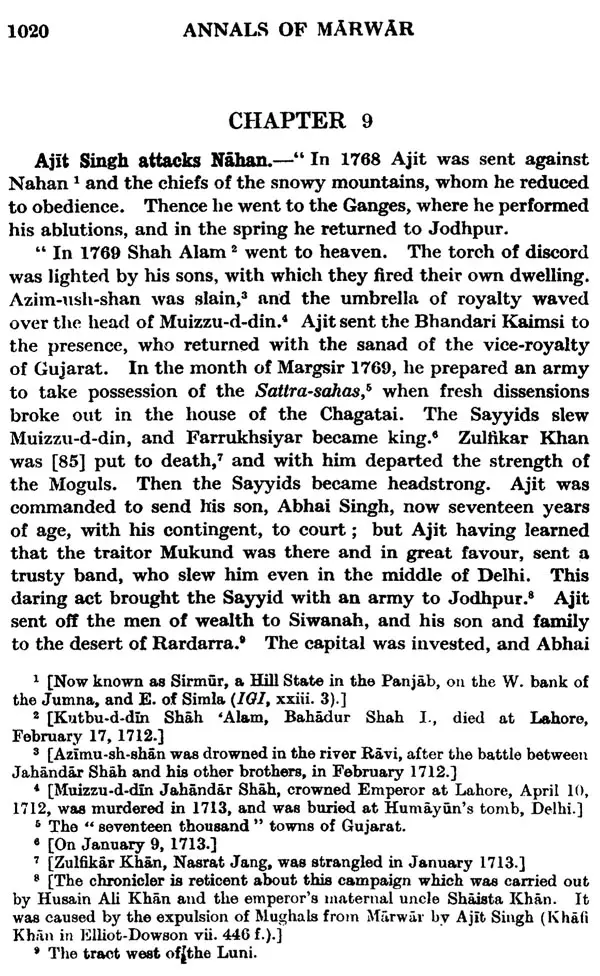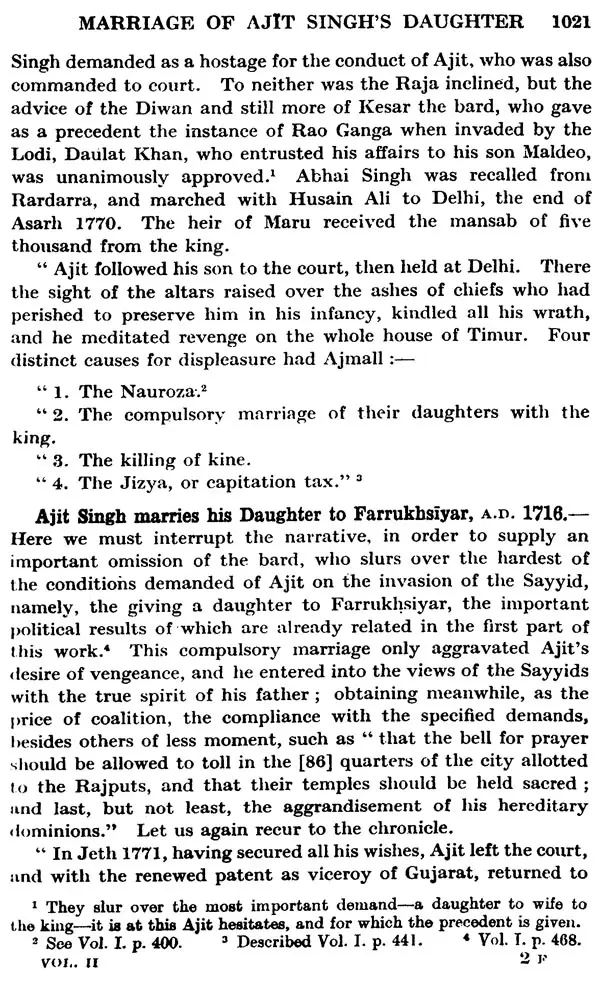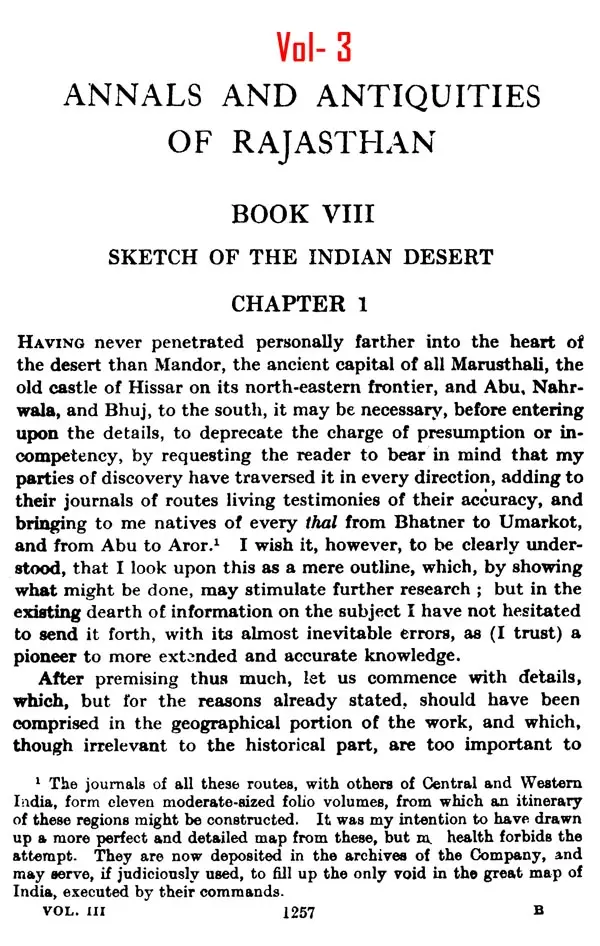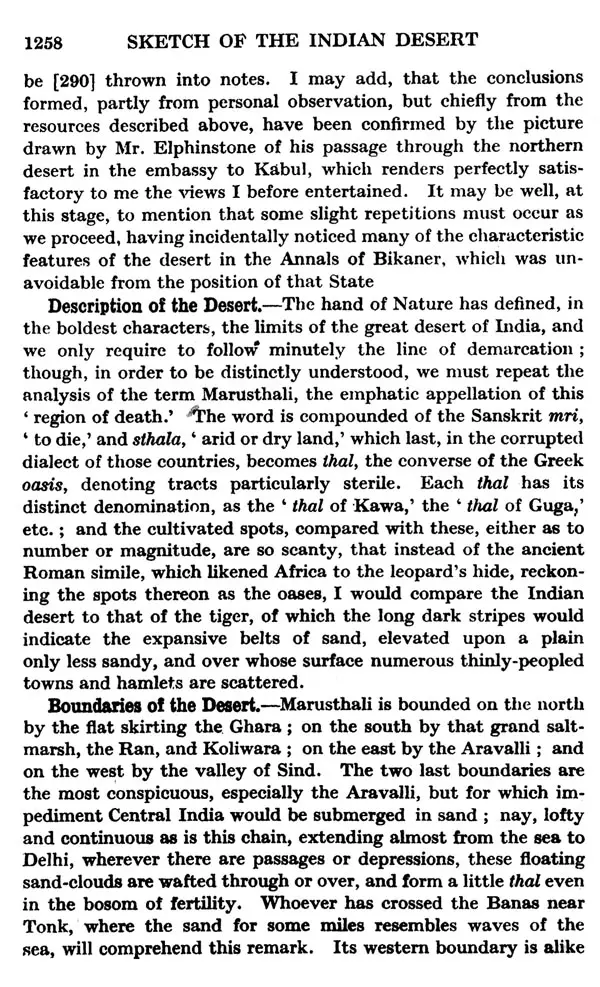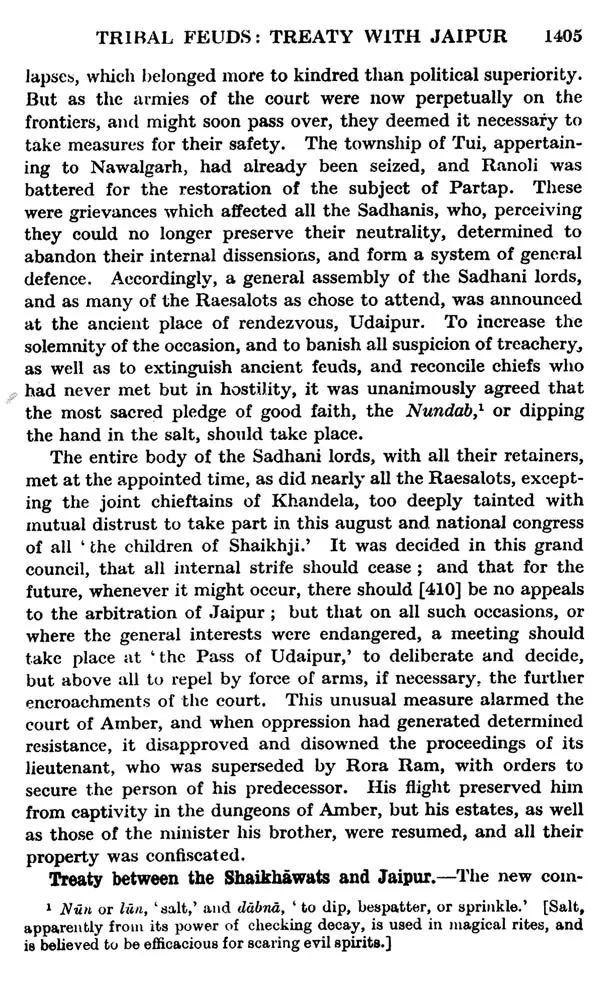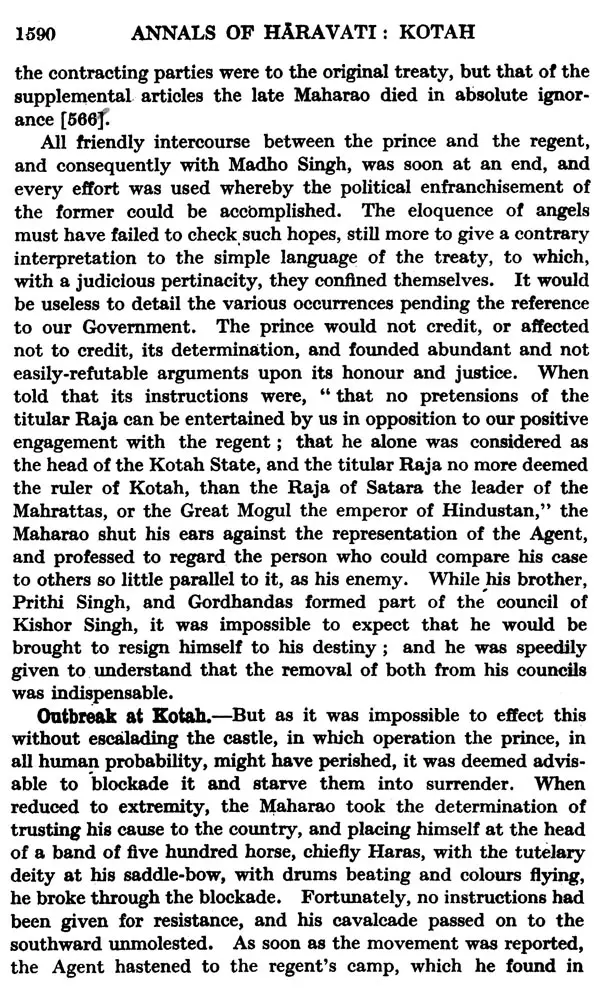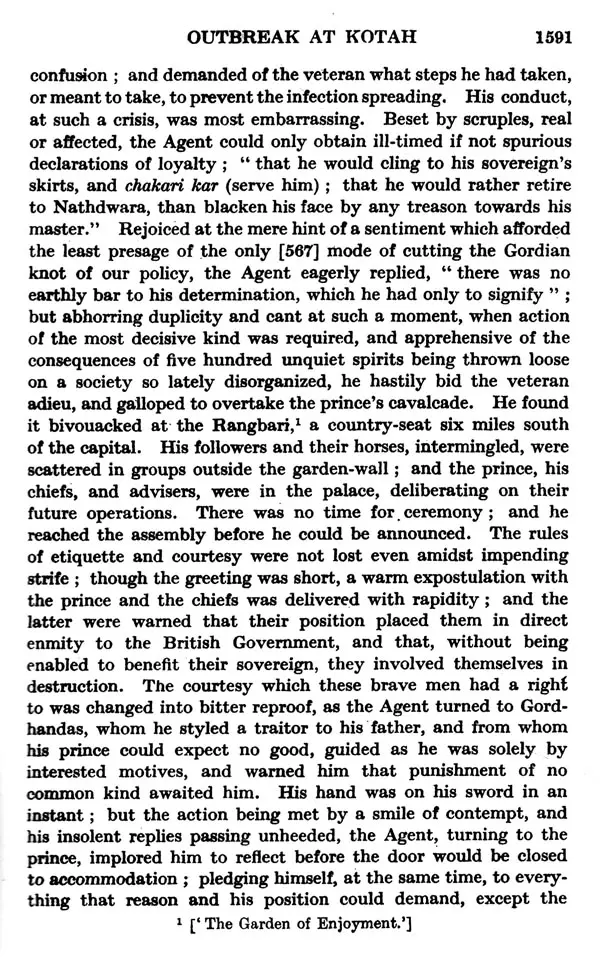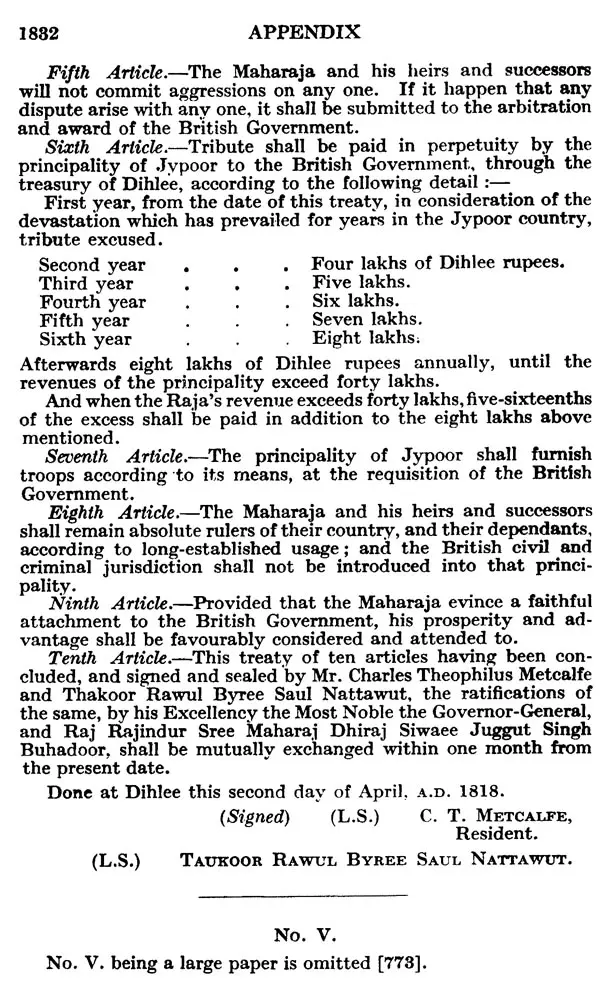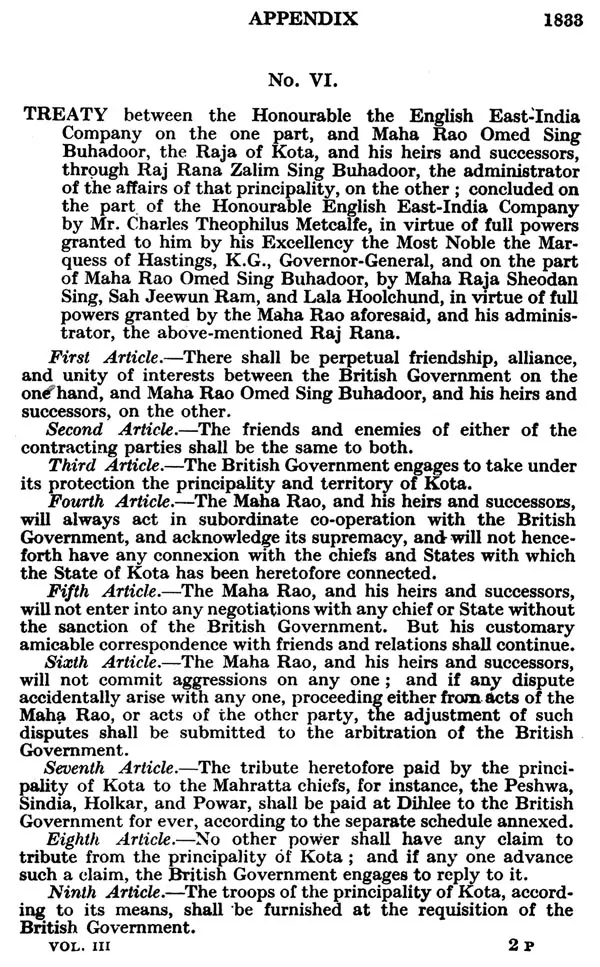
Annals and Antiquites of Rajasthan (Set of 3 Volumes)
Book Specification
| Item Code: | UBB900 |
| Author: | James Tod And William Crooke |
| Publisher: | MOTILAL BANARSIDAS PUBLISHERS PVT.LTD |
| Language: | English |
| Edition: | 2021 |
| ISBN: | 9788194137498 |
| Pages: | 1862 |
| Cover: | PAPERBACK |
| Other Details | 7.00 X 5.00 inch |
| Weight | 1.49 kg |
Book Description
This work relates to the (erstwhile) central and western Rajput states of India. It embodies the results of scholarly investigation into the ethnology of Rajputs their religious and social practices their festivals and rites their legal and political institutions and the merits and demerits of their characters. Herein we get a real portrait of the different aspects of Rajput life: their loyalty, devotion, gallantry, chivalry as also the instability of their character their outbreaks of passion fears occasional faithlessness of their chiefs and allies and above all their addiction to drugs.
The work is divided into three volumes: each volume being sub divided into book and chapters. Vol. I deals mostly with the geography of Rajasthan the history of the Rajput tribes and the feudal system of their states. Vol. II contains the Annals of marwar Bikaner, Jaisalmer and other cities of Rajasthan. Vol. III comprise the annals of amber, Haravati, Bundi and describes Shaikhawat federation and contains personal narrative from Udaipur to kheroda. It has an appendix divided into kheroda. It has an appendix divided into seven section and exhaustive general index.
Interspersed with several illustrations this book is remarkable for its enlightening introduction and exegetical notes.
No one can undertake with a light heart the preparation of a new edition of colonel Tod’s great work, The Annals and antiquities of Rajasthan. But the leading part which the Rajputs have taken in the great war the summoning of one of their princes to a seat at the imperial conference the certainty that as the result of the present cataclysm they will be entitled to a larger share in the administration of India have contributed to the desire that this classical account of their history and sociology should be presented in a shape adapted to the use of the modern scholar and student of Indian history and antiquities.
In the introduction which follows I have endeavoured to estimate the merits and defects of colonel Tod work. here it is necessary only to state that though the book has been several times reprinted in India and once in this country the obvious difficulties of such an undertaking have hitherto prevented any writer better qualified than myself from attempting to prepare an annotated edition. Irrespectively of the fact that this work was published a century ago when the study of the history antiquities sociology and geography of India has only recently started the authors method led him to formulate theories on a wide range of subjects not directly connected with the Rajputs in the light of our present knowledge some of these speculations have become obsolete and it might had been possible without impairing the value of the work as a chronicle of the Rajputs to have discarded from the text and notes much which no longer possesses value. But the work is a classic and it deserves to be treated as such and it was decided that any mutilation of the original text and notes would be inconsistent with the object of this series of reprints of classical works on Indian subject. The only alternative course was to correct in notes clearly distinguished from those of the authors such fact and theories as are no longer accepted by scholars.
It is needless to say that during the last century much advance has been made in our knowledge of Indian antiquities philology and sociology. we are now in a position to use improved translation of many authorities which were quoted by the author translations of many authorities which were quoted by author from inadequate of incorrect versions. The translation of Ferishta History by A. dow and and Jonatham scott has been superseded by that of general J. Briggs that of the Ain-i-akbari of F. Gladwing by the version by professor H. blochman and colonel H.S. Jarrett. For the memoirs of jahagir the author relied on the imperfect version by professor H. Blochmann and colonel H.S. Jarrett. For the memoirs of Jahagir the author relied on the imperfect version by major David price which has been replaced by a new translation of the text in its more complete from by messrs. A. Rogers and H. Beveridge. For the laws of manu we have the translation by Dr. G. Buhler. The passages in classical literature relating to India have been collected translated and annotated by the late Mr. J.Q. Mecrindle. Much information not available for the authors use has been provided by the history of India as told by its own historians by Sri H.M. Elliot and professor J. Dowson and by Mr. W. Irvine translation with elaborates note of N. Manucci storia do magor among original works useful for the present edition the following may be mentioned: J Grant Duff history of the Mahrattas: Dr. Vincent A. Smith Early history of India history of fine art in India and Ceylon Asoka the Buddhist emperor of India and akbar the great Mogul; professor Jadunah Sarkar history of Aurangzib of which only three volume have been published; Mr. W. Irvine Army of the Indian Moghuls; Sir W. Lee-Warner Protected Princes of India.
Much historical geographical and ethnological information has been collected in the new edition of the imperial Gazetteer of India the Bombay Gazetteer edited by Sir J.M. Campbell and more particularly in the revised Gazetteer of Rajputana including that of Mewar and the western states residency and Bikaner agency by lieutenant colonel K.D. Erskine and that of Ajmer by Mr. C.C. Watson. Lieutenant colonel Erskine work based on the best local information has been of special value and it is much to be regretted that this officer after serving as consul general at Baghdad, was invalided and died in England in 1914, leaving that part of the Gazetteer dealing with the eastern states Jaipur, Kotah, and Bundi University. For botany agriculture and natural productions I have uses Sir G. Watt dictionary of the economic products of India and his commercial products of India and eastern architecture edited by Dr. J. Burgess and the cave temples of India by the same writers. In ethnology I have consulted the publication of the ethnological survey of India of which Mr. H.A. Rose glossary of the tribes and castes of the Punjab and North West frontier province Mr. Bhimbhai Kirparam account of the Hindusand Khan Bhahadur Fazalullah Lutfullah of the musalmans of Gujarat, Published in the Bombay gazetteer vol.ix. Parts i.ii., have been specially valuable. Besides the general works to which reference has been made many articles on Rajputana and the Rajputs will be found in the journal of the royal Asiatic society of Bengal and the Indian antiquary and other periodicals. The reports of the Archaeological survey of India conducted by Sir A. Cunnigham Dr. J. Burges and sir J.H. Marshall bare of great important.
I cannot pretend to have exhausted the great mass of new information available in the work to which I have referred and in others names in the bibliography and it was not my object to overload the notes which are already meticulous; but no other course seemed possible if the work was to be made more useful to the historian and to the scholar. The editor of a work of this class is forced to undertake the somewhat invidious duty of calling attention to oversights or errors either in fact or theory. But this does not detract from the real value of the work. in some cases I have been contents with adding a note of interrogation to warn the reader that certain statements must be received with caution. As regards geography I have in many cases indicated briefly the position of the more important places so far as they can be traced in the maps with which I was provided. The author was so intimately acquainted with the ground that he assumed in the general reader a degree of knowledge which he does not possess.
The text and notes with the exception of a few obvious over sights have been reprinted as they stood in the first edition and as the latter is often quoted in books of authority I have added its pagination for facility of reference. It was decided after much consideration to correct the transliteration of personal and place name and other vernacular terms according to the system now adopted in official gazetteers maps and reports. This change might have been unnecessary if the transliteration of these words according to the system in use at the time when the book was written had been uniformly correct. But this is not the case. At the same time I have preserved the original readings of those names which have become established in popular usage such as Mogul Mahratta Deccan in place of Mughal Marhata Dakkhin following the author example I have not thought it necessary to overload the text by the use of accents and diacritical marks which are useless to the scholar and only embarrass the general reader. But in the index I have accentuated the personal and place names so far as I believed I could do so with safety. Some of these I have been unable to trace in later authorities and I fear that I may have failed to secure complete uniformity of method.
The scheme of the book which attempts to give parallel accounts of each state naturally causes difficulty to the reader. A like embarrassment is felt by any historian who endeavors to combine in a single narrative the fortunes of the Mughal empire with those of the kingdom in Bengal the Deccan or southern India; by the historian of Greece where the centre of activity shifts from Athens so Sparta Thebes or Macedonia; by the historian of Germany before the minor kingdom were more or less fully absorbed by the Hohenzollerns. I have endeavored to assist the reader in dealing with these independent annals by largely extending the original index and by the use of page heading and paragraph summaries.
In the dates recorded n the summaries I have generally followed lieutenant colonel Erskine guidance so far as his work was available. In view of the inconsistencies between some dates in the text and those recorded in the summaries it must be remembered that it was the authors habit in adapting the dates of the Samvat to hose of the Christian era, to deduct 56, not 57 from the former contrary to the practice of modern historians.
I am indebted to many friends for assistance. Captain C.D. M.K. blunt has kindly give me much help in the record of colonel Tod like and has supplied a photograph of the charming miniature of the author as a young officer and of a bust which have been reproduced in the frontispieces. Mr. R.E. Enthoven C.I.E., has given me the photographs of the author engaged in his studies with his Jain Guru. The fragments of local ballads scattered through the text were unfortunately copied from very incorrect text. Dr. L.P. Tessitori an Italian scholar who until the outbreak of the war was engaged in collecting the local ballads of the Rajputs has given a correct version of these Ballads; and in improving the text of them I have been assisted by colonel C.E. luard his pandit and sir G. grieroson K.C.I.E. since the greater part of the following pages was in type was in type I have received copies of three reports by Dr. L.P. Tessitori A scheme for the Bardic and historical survey of Rajputana and two progress Reports for the years 1915 and 1916 published in the journal of the Asiatic society of Bengal (new series vol. x. no. 10; xii. No. 3; xiii. No.4). these contain information regarding the MSS. Copies of some ballads and inscriptions which throw light on the traditions and antiquites of the Rajputs. I regret that I was unable to use these papers which however do not supply much information on question connected with the Annals. Among other friends who have helped me in various ways I may names the late sir G. Birdwood; Mr. W. foster C.I.E.; professor A. Keith, F.R.S.; lieutenant colonel Sir D. Prian F.R.S; and Dr. Vincent A. Smith C.I.E.
James ton the author of this work son of James Tod and Mary healthy was born at islington on March 20, 1782. His father James Tod the first eldest son of Henry Tod of Bo’ness and janet Monteath was born on October 26, 1745. In 1780 he married in New York Mary daughter of Andrew Heatly a number of a family originally settled at mellerston Co. Berwick where they had held a landed estate for some four centuries. Andrew heatly emigrated to Rhode Island where he died at the age of thirty six in 1761. He had married Mary daughter of suet on grant of the family of Gartinbed really of Balvaddon who left Inverness for Newport Rhode Island in 1725 and Temperance Talmage or Tollemache granddaughter of one of the first and principle settlers at Easthampton Rhode Island. He had been forced to emigrate to America during the protectorate owing to his loyalty to king Charles I. James Tod the first left America and in partnership with his brother john became an indigo-planter at Mirazpur in the united provinces of Agra and oudh.
James Tod the second was thus through his father and his uncles Patrick and S. Heatly both member of the civil service of the east India company closely connected with India and in 1798 being then sixteen years old he obtained through the influence of his uncle Patrick heatly both member of the civil service of the east India company closely connected with India and in 1798 being then sixteen years old he obtained through the influence of his uncle Patrick healty a cadetship in the service of the east India company on his arrival at Calcutta he was attached to the 2dn European regiment. In 1800 he was transferred with the rank of lieutenant to the 14the native infantry from which he passed in 1807 with the same rank to the 25th Native infantry. In 1805 he was appointed to the command of the escort of his friend Mr. Graeme Mercer then government agent at the camp of Daulat Rao sindhia who had been defeated two years before at the battle of Assaye by sir Arthur Wellesley. In more than one passage in The annals Tod Speaks of Mr. Graeme mercer with respect and affection and by him he was Graeme mercer with respect and affection by him he was introduced to official life and Rajput and Mahratta politics. His tastes for geographical inquiries led him to undertake surveys in Rajputana and central Indian between 1812 and 1817 and he employed several native surveyors to traverse the then little known region between central India and the valley of the Indus.
At this period the government of India was engaged in a project for suppressing pindaris a body of lawless free booters of no single race the debris of the adventurers who gained power during the decay of the mughal empire and who had not been incorporated in the armies of the local powers which rose from its ruins. In 1817 to effect their suppression the governor-general the Marquess of Hastings collected the strongest British force which up to that time had been assembled in India. Two armies acting in cooperation from north and south converged on the banditti and met with raped success. Sindhia whose power depended on the demoralized condition of Rajputana was overawe; Holkar was defeated; the Raja of Nagpur was captured the mahratta peshwa become a fugitive; the Pindaris were dispersed. One of their leaders Amir Khan who is frequently mentioned in Tod narrative disbanded his forces and received as his share of the spoils the principality of tonk still ruled by his descendants.
In the course of this campaign Tod performed valuable services. At the beginning of the operations he supplied the British staff with a rough map of the seat of war and in other ways his local knowledge was utilized by the Generals in charge of the operations. In 1813 he had been promoted to the rank of captain in command of the escort of the Resident Mr. Richard stracehy who nominated him to the post of his second assistant. In 1818 in was appointed political agent of western Rajputna a post which he held till his retirement in June 1822. The work which he carried out in Rajputana during this period is fully described in the Annals and in his personal narrative. Owing to Maharatta oppression and the ravages of the pindaris the condition of the country political social and economical was deplorable. To remedy this prevailing anarchy the states were gradually brought under British control and their relation with the paramount power were embodied in a series of treaties. In this work of reform reconstruction and conciliation, Tod playd an active part and the confidence and respect with which he was regarded by the princes chiefs and peasantry enabled him to interfere with good effect in tribal quarrels to rearrange the felts of the minor chiefs and to act as arbitrator between the Rana of Mewar and his subjects.
Tod was convinced that the miserable state of the country was chiefly due to the hesitation of the Indian government in he does not hesitate to condemn the cautious policy of Lord Cornwallis during his second term of office as governor General. Few people at the present day would be disposed to defend the policy of non intervention. This policy has been condemned by historians and commentators as well as by statesmen soldiers and diplomatists; by mill and his editor H.H. Wilson and by thornton; by lord lake and sir John Malcolm. The mischief was done and the loss of influence was not regained for a decade. It was not till the conclusion of an expensive and protracted campaign that the Indian government was replaced in the position where it had been left by Wellesley. The blame for this weak and unfortunate policy must be divided between Cornwallis and barlow between the court of directors and the Board of control. But it was carried out in pursuance of orders from the home government. The court of directors for some time past had been alarmed at lord wellseley vigorous foreign policy. Castleragh at the Board of control had taken fright and even pitt was carried away and committed himself to a hasty opinion that the governor-general had acted imprudently and illegally.
Tod tells us little of his relations with the supreme government during his four years service as political agent. He was notoriously a partisan of the Rajput princes particularly those of Mewar and Marwar; he is never dried of abusing the policy of the Emperor Auragzeb and fortunately for the success of his work Muhammadams form only a slight minority in the population of Rajputana. His attitude naturally exposed him to criticism. Writing in 1824 Bishop Heber while he recognizes that he was held in affection and respect by all the upper and middling classes of society goes on to say: His misfortune was that in consequence of his favoring the native princes so much the government of Calcutta were led to suspect him of corruption and consequently to narrow his power and associate other officers with him in his trust till he was disgusted and resigned his place. They are now I believe well satisfied that their suspicions his place. They are now I believe well satisfied that their suspicions were groundless. Captain Todd is strenuously vindicated from the charge by all the officers with whom I have conversed and some of whom had abundant means of knowing what the natives themselves thought of him. The bishop widow in a later issue of the diary of her husband adds that she is anxious to remove any unfavorable impression which may exist on the subject by stating that she has now the authority of a gentleman who at the time was a member of the supreme council to say that no such imputation was ever fixed on colonel Todd character.
Whatever may have been the real reason for the premature termination of his official career at the age of forty ill-health was put forward as the ostensible cause of his retirement. He had served for about twenty four years in the Indian plains without any leave; he had long suffered from malaria; and though he hardly suspected it at the time an attempt had been made by one of his servants to poison him with datura; he had met with a serious accident when by chance or design his elephant driver dashed him howdah against the gate of begun fort in eastern Mewar. In spite of all this he retained sufficient health to makes on the eve of his departure from India the extensive tour recorded in his departure from Indian the extensive tour recorded in his travels in western India. Neither on his retirement nor at any subsequent period were his services official and literary rewarded by any distinction.
During the seventeen years service in central India and Rajputana he showed indefatigable industry in the collection of the materials which were partially used in his great work. his taste for the study of history and antiquities ethnology popular religion and superstitions was stimulated by the pioneer work of Sir W. Jones and other writers in the Asiatic Researches. He was not a trained philologist and he gained much of his information from his Guru the Jain Yati Gyanchandra and the Brahman Pandits whom he employed to make inquires on his behalf. They too were not trained scholars in the modern sense of the time and many of his mistakes are due to his rashness in following their guidance.
His life was prolonged for thirteen years after he left India. In 1824 he attained the rank of Major and in 1826 that of lieutenant colonel. Much of his time in England was spent in arranging his materials and compiling the works upon which his reputation depends: The annals published between 1826 and 1832: and his Travels in western India published after his death in 1839. He was in close relation with the Royal Asiatic society of which he acted for a time as librarian. In this fine collection of books and manuscript he gained much of that discursive learning which appears in the Annals. He presented to the society numerous manuscript inscriptions and coins. The fine series of drawings made to illustrate his works by Captain P.T. Waugh and a native artist named Ghasi have recently been rearranged and catalogued in the Library of the society they well deserve inspection by anyone interested in Indian art. He also made frequent tours on the continent and on one occasion visited the great soldier count Benoit de Boigne who died in 1830 leaving a fortune of twenty million of francs.
On November 16, 1826, Tod married Julia daughter of Dr. Henry clutter buck an eminent London surgeon by whom he had two sons and a daughter. In 1835 he settled in a house in Regent park and on November 17 of the same years he died suddenly while transacting business at the office of his bankers messrs. Robarts of Lombard street. The names of his descendant will appear from the pedigree appended to this introduction.
The annals of Rajasthan the two volumes of which were by permission dedicated to kings George IV. and William IV. respectively was received with considerable favors. A contemporary critic deals with it in the following terms: Colonel Tod deserves the praise of a most delightful and industrious collector of materials for history and his own narrative style in many places displays great freedom vigour and perspicuity. Though not always correct and occasionally stiff and formal it is not seldom highly animated and picturesque. The faults of his work are inseparable from its nature it would have been almost impossible to mould up into one continuous history the distinet and separate annals of the various Rajput races. The patience of the reader is thus unavoidably put to a server trial in having to reascend to the origin and again to trace downwards the parallel annals of some new tribe sometimes interwoven with sometimes entirely distinct from those which have gone before. But one the whole as no one but colonel Tod could have gathered the materials for such a work there are not many who could have used them so well. No candid reader can arise from its perusal without a very high sense of the character of the author no scholar more certainly without respect for his attainment and gratitude for the service which he rendered to a branch of literature if far from popular by no means to be estimated as to its real importance by the extent to which it may command the favour of an age of duodecimos.
In estimating the value of the local authorities on which the history is based, Tod reposed undue confidence in the epics and ballads composed by the poet chand and other tribal bards. It is believed that more than one of these poem have disappeared since his time and these materials have been only in part edited and translated. The value to be placed on bardic literature is a question not free difficulty. On the faith of ancient songs the uncertain but the only memorials of barbarism sys Gibbon they [Cassiodorus and Jornandes] deduced the first origin of the Goths. The poet may occasionally record facts of value but in his zeal for the honour of the tribe which he represents he is tempted to exaggerate victories to minimize defeats. This is a danger to which Indian poet are particularly exposed. Their trade is one of fulsome adulation and in a state of society like that of the Rajputs where tribal and personal rivalries flourish the temptation to give a false coloring the history is great. In fact bardic literature is often useful not as evidence of occurrence in antiquity but as an indication of the habits and beliefs current in the age of the writer. It exhibits the facts not as they really occurred but as the writer. It exhibits the facts not as they really occurred but as the writer and his contemporaries supposed that they occurred but as the writer and his contemporaries supposed that they occurred. The mind of the poet with all its prejudices projects itself into the distant past. Good examples of the methods of the bards will appear in the attempt to connect the Rathors with the dynasty of Kanauj or the represent the Chauhans as the founder of an empire in the Deccan.
Recent investigation has thrown much new light on the origin of the Rajputs. A wide gulf lies between the vedic Kshatriy and the Rajpur of medieval times which it is now impossible to bridge. Some clans with the help of an accommodating bard may be able to trace their lineage to the Kshatriyas of Buddhist time who were recognized as one of the leading elements in Hindu society and in their own estimation stood even higher than the Brahmans. But is now certain that the origin of many clans dates from the saka of Kushan invasion which began about the middle of the second century or more certainly from that of the white Huns who destroyed the Gupta empire about A.D. 480. The Gurjara tribe connected with the latter people adopted Hinduism and their leaders formed the main stock from which the higher Rajput families Sprang. When these new claimants to princely honours accepted the faith and institutions of Brahmanism the attempt would naturally be made to affiliate themselves to the mythical heroes whose exploits are recorded in the Mahabharata and Ramayana. Hence arose the body of legend recorded in The Annals by which a fabulous origin from the sun or moon is ascribed to two great Rajput branches a genealogy claimed by other princely families like the incas of peru of the Mikado of Japan. Or as in the case of the Rathors of Marwar an equally fabulous story was invented to link them with the royal house of Kanauj one of the genuine old Hindu ruling families. The same feeling lies at the root of the Aenied of Virgril the court poet of the new empire. The clan of the emperor Augustus the Iulii a patrician family of Alban origin was represented as the heirs of Iulus the supposed son of Aeneas and founder of Alba Longa thus linking the new Augustan house with the heroes of the Iliad.
One of merits of Tod work is that though his knowledge of ethnology was imperfect and he unable to reject the local chronicles of the Rajputs he advocated in anticipation of the conclusions of later scholars the so called seythic origin of the race. To make up for the lack of direct evidence of seythian manners and sociology to support this position e was forced to rely on certain superficial resemblances of custom and belief not between Rajputs Seythians and huns but between Rajputs getae or Thracians or the Germans of Tacitus. In the same way a supposed identity of name led him to identify the Jats of northern India with the getae or with the Goths and finally to bring them with the jutes into kent.
A similar process of groping in semi darkness indueed him to make constant reference to serpent worship which as sir e. Tylor remarked years ago fell into the hand of speculative writers who mixed it up with occult philosophies druidical mysteries and that portentous nonsense called the Arkit symbolism till now sober student hear the very name of ophiolatry with a shudder. He repeatedly speaks of a people whom he calls the Takshaks apparently one of the seythian tribes. there is however no reason to believe that serpent worship formed an important no reason to believe that serpent worship formed an important element in the beliefs of a seythians or to suppose that the cult as we observe it in India is of other than indigenous origin.
The more recent views of the origin of the Rajputs may be briefly illustrated in connexion with some of the leading septs. Dr. Vincent A. Smith holds that the term Kshatriya was not an ethnical but an occupational designation. Rajaputra son of a Raja seems to have been a name applied to the cadets or ruling house who according to the ancient custom of tribal society were in the habit of seeking their fortunes abroad winning by some act of valour the hand of the princess whose land they visited and with it the succession to the kingdom vested in her under the system of Mother right. Sir James frazer has described various form of this mode of succession in the case of the kings of Rome Ashanti Uganda in certain Greek states and other places. Dr. Smith goes on to say: The term Kshatriya was I believe always one of very vagus meaning simply denoting the Hindu ruling classes which did not claim Brahmanical descent. Occasionally a raja might be a Brahman by caste but the Brahman place at court was that of a minister rather than that of king. This office in Rajputana as we learn from numerous instances in the annals was often taken by members of the Bania or mercantile class because the Brahmans of the desert by their laxity of practice had acquired an equivocal reputation and were generally illiterate. The Rajput has always until recent times favoured the Bhat or bard more than the Brahman.
The group denoted by the name Kashatiya or Rajput thus depended on status rather than on decent and it was therefore possible for foreigner to be introduced into the tribes without any violation of the prejudices of caste which was then only partially developed. In later times under Brahman guidance the rules of endogamy exogamy and confarreatio have been delinitely formulated. But as the power of the priesthood increased it was necessary to disguise this admission have been definitely formulated. But as the power of the priesthood increased it was necessary to disguise this admission of foreigner under a convenient fiction. Hence arose the legend told in two different form in The Annals which describes how by a solemn act of purification or initiation under the superintendence of one of the ancient Vedic Rishis or inspired saints the fire born septs were created to help the Brahamans in repressing Buddhism Jainism or other heresies and in establishing the ancient tradition Hindu social policy the temporary downfall or which under the stress of foreign invasion is carefully concealed in the Hindu sacred literature. This privilege was we are told confined to four sept known as Agnikula or fire born the pramar parihar chulukya or solanki and the Chauhan. But there is good reason to believe that the Pramar was the only sept which laid claim to this distinction before the time of the poet chand who flourished in the twelfth century of our era. The local tradition in Rajputana was so vague that in one version of the story vasisth in a other Vishvamitra is said to have been the officiating priest.
In the case of the sesodias of Mewar Mr.D.R. Bhandarkar has given reasons to believe that gehlot or Guhilot means simply son of Guhila an abbreviation of Guhadatta the name of its founder. He is said to have belonged to the Gurjara stock kinsmen or allies of the huns who entered India about of sixth century of our era and founder a kingdom in Rajputana with its capital at Bhilmal or srimal about fifty miles from mount Abu the scene of the regeneration of the Rajpurs. This branch which took the name of maitrika is said to be closely connected with the Mer tribe which gave its name to Merwara and is fully described in the Annals. The actual conqueror of chitor Bapa of Bappa is said in inscription to have belonged to the branch known as Nagar of city Brahmans which has its present headquarters at the town of Vadnagar I the Baroda state. This conversation of a Brahman into a Rajput is atfirst sight starting but the fact implies that the institution of caste as we observe it was then only imperfectly established and there was no difficulty in believing that a Brahman could be ancestor of a princely house which now claims descent from the sun. as will appear later on Bapa seems to be a historical personage. These facts help us to understand the strange story in the annals which tell now Gohabditya received inauguration as chief by having his forehead smeared with blood drawn from the finger of Bhil a form of the blood covenant which appears among many savage tribes. in those days no definite line was drawn between the Bhil sow a wild forest tribe and the Rajputs. The bhils were the free iords of the jungle original owners of the sod and thought they practiced rites and followed customs repulsive to orthodox Hindu they did not share in the impurity which attached to foul outcastes like the Dom or the chandala. As the bhils were believed to be autochthonous and thus understood the methods of controlling or conciliating the local spirits by this form of inauguration they passed on their knowledge to the Rajputs whom they accepted as their lords. The relation of the minas another jungle tribe of the same class with the kachhwahas of Jaipur were of the same kind.
According to the baric legend given in the annals the rathors to second great Rajpur clan owed their origin to a migration of a body of its members to the western desert when the territory of Kanauj was conquered by shihabu-d-din in A.D. 1193. But it is now certain that the ruling dynasty of Kanauj belonged not to the Rathor but to the Gaharwar clan and that the first Rathor settlement in Rajputana must have occurred anterior of the conquest of Kanauj by the Musalman. An inscription dated found in the ruins of the ancient town of Hathudni or in the Bali Hakumat of the Jodhpur state names four Rathor Rajas who reigned there in the tenth century. The local legend is an attempt to connect the line of Rathor princes with the Kanauj dynasty. It has been suggested that the Deccan dynasty of the Rasjtrakutas which in name at least is identical with Rathor reigning at Nasik or Malkhed from was connected with the raddis or Raddis a caste of cultivators which seem to have migrated from Madras into the Deccan at an early period. But any racial connexion between the Deccan Reddis and the Rathors of Rajputana is very doubtful.
The chandel clan ranked in the Annals among the thirty six royal races is believed to be closely connected with the Bhars and Gonds forest tribes of Bundelkhand and the cntral Bhars alone on the ground that the Gonds according to the best traditions entered the central provinces from the south and made no effective settlement in Budelkhand the headquarters of the chandesl. But there was a Gond settlement in the hamirpur district of Bundelkhand and the close connexion between the Gonds and the chandels began in what is now the chhatarpur state.
The results of recent investigation into Rajput ethnology are thus of great importance and enable us to correct the bardic legends on which the genealogies recorded in the Annals were founded. Much remains to be done before the question can be finally settled. The local Rajput traditions and the ballads of the bards must be collected and edited; the ancient sites in Rajputana must be collected and excavated; physical measurement now somewhat discredited as a test of racial affinities must be made in larger number and by more scientific methods. But the general thesis that some of the nobler Rajput septs are descended from Gurjaras or other foreigners while others are closely connected with the autochthonous races may be regarded as definitely proved.
One of the most valuable parts to the Annals is the chapter describing the popular religion of Mewar the festival describing the popular religion of Mewar the festival and rites in honour of Gauri the mother goddess. There are also many incidental notices of cults and superstitions scattered through the work. a race work. a race of warrior like the Rajputs naturally favours the worship of siva who as the successor Rudra the Vedic storm god was originally a terror inspiring deity a side of his character only imperfectly veiled by his euphemistic title of Siva the blessed or auspicious one. In his phallic manifestation his chief shrine is at Eklingji the shingle or notable phallus about fourteen miles north of Udaipur city. The Ranas hold the office of priest kings. Diwans or prime ministers of the god. Their association with this deity has been explained by an inscription dated is in form of a dedication to Lakulisa a form of siva represented as bearing a club and refers to the saiva sect known as Lakulisa pasapatas. It records the name of a king named Sri Bappaka the moon among the princes of the Guhila dynasty who reigned at a place called Nagavada identified with Nagda an ancient town several time mentioned in the annals the ruins of which exist at the foot of the hill on which the temple of eklingji stand. Sri Bappaka is certainly Bapa or Bappa the traditional founder of the mewar dynasty which had at that time its capital at Nagda. From this inscription it is clear that the Eklingji temple was in existence before and as Mr. Bhandarkar remarks it shown that the sold tradition about Nagedra and Bappa Rawal infancy given by Tod had some historical foundation and it is intelligible how the Ranas of Udaipur could have come to have such an intimate connexion with the temple as that of high priests in which capacity they still officiate. This office vested in them is a good example of one of those dynasties of priest king of which sir James Frazer has given an elaborate account.
The milder side of the Rajpur character is represented in the cult of Krishna at Nathdwara. The Mahant or Abbot of the temple situated at the old village of Siarh twenty two miles from the eity of Udaipur enjoys semi royal state. In anticipation of the by Aurangzeb on Mathura the ancient image of Kesvadeva a form of Krishna he of the of the flowing locks was removed out of reach of danger by Rana Raj Singh of Mewar. When the cart bearing the image arrived at siarh the god by stopping the cart is said to have expressed his intention of remaining there. This was the origin of the famous temple still visited by crowds of pilgrims and one of the leading seats of the Vallabhacharya sect the Epicureans of the east whose practices a disclosed in the famous Maharaja libel case tried at Bombay in 1861 gave rise to grievous scandal. The ill feeling against this sect aroused by these revelation was so intense that the Maharaja of Jaipur ordered that the two famous images of Krishna worshiped in his state which originally came from gokul near Mathura should be removed from his territories into those of the Bharatpur state.
Tod bear witness to the humanizing effect on the Rajputs of the worship of this god whom he calls the Apollo of Braj the holy land of Krishna near Mathura. He also asserts that the Emperor Akbar favoured the worship of Krishna a feeling shared by his successors Jahangir and Shah Jahan. Akbar in his search by his successors Jahangir and Shah Jahan. Akbar in his search for a new faith to supersede Islam of which he was parcus cultor et infrequens dallied with Hindu Pandits Prsi priess and Christian missionaries and he was doubtless well informed about the sensuous ritual of the temple of Nathdwara.
The character of the Rajputs is discussed in Many passages in the Annals. The author expresses marked sympathy with the people among whom his official life was spent and he expresses gratitude for the courtesy and confidence which they bestowed upon him. This applies specially to the sesodias of Mewar and the Rathors of Marwar with whom he lived in the closets intimacy. He shows on the other hadn a decided prejudice against the Kachhwahas of Jaipur of whose diplomacy he disapproved. This feeling we may suspect wad due in part to their hesitation in accepting the British alliance a policy in which he was deeply interested.
